| |||||||
 |
| Search this Thread |  3,015,972 views |
| | #1 |
| Team-BHP Support  | Volkswagen Taigun Review Volkswagen Taigun ReviewVolkswagen Taigun Pros
Volkswagen Taigun Cons
IntroductionIndia 2.0 - the grand, ambitious, billion Euro plan that the Volkswagen Group formulated for the Indian market, is finally bearing fruit! Despite being the second-largest car manufacturer in the world, the VW group has been an ordinary performer in the Indian market. All it could do lately was to try and keep the old Polo platform relevant, while filling its portfolio with niche imports. Indians love SUVs / crossovers and VW didn’t have any in the affordable segments! The India 2.0 project aims to change all that and the future is claimed to be “SUVW”  ! Skoda, the new group leader for India, has taken the first-mover advantage with the Kushaq, which was launched in June. But now, Volkswagen is finally in hustle mode to introduce its brand new car - the Taigun. ! Skoda, the new group leader for India, has taken the first-mover advantage with the Kushaq, which was launched in June. But now, Volkswagen is finally in hustle mode to introduce its brand new car - the Taigun.Interestingly, this is the second time we are welcoming the Taigun nameplate in India, and it still manages to confuse us at times (Tiguan - Taigun). The Volkswagen Taigun (Volkswagen @ Auto Expo 2014) concept was one of the stars of the 2014 Delhi Auto Expo. It was expected to arrive in the Indian market in 2016 as a Ford EcoSport rival based on the UP platform and sporting a 1.0 TSi engine. What we have received now instead, is a localised version of the T-Cross, a new MQB A0-based crossover revealed in 2018. A truly international product that wears different faces for different markets (Europe, Brazil), the car receives jazzier styling for Asian markets. Known also as the Tacqua in China, the T-Cross has been heavily localised for India with the MQB-A0-IN platform and christened the Taigun (“the energy of the Taiga forest”, no Sanskrit here). Unlike the 2014 concept, the real deal enters the lucrative midsize SUV / crossover market rivaling the likes of the mighty Creta, Seltos and its own cousin - the Skoda Kushaq. In our opinion, Volkswagen also played it wise with the “GT” badge on the variants with the better performing 1.5 TSI motor. From the time of its launch in 2013, the Polo GT has been one of the rare success stories of a performance-oriented moniker in the Indian market, and the company is hoping to cash in on that GT-love now. This 4-cylinder motor produces 148 BHP & 250 Nm and comes paired with a 6-speed MT or a 7-speed AT (yes, the much loved, but dreaded DQ200 dual-clutch DSG). However, the mainstay of the range will be a 1.0L, 3-cylinder TSI motor that produces 113 BHP and 178 Nm and is paired with a 6-speed MT or torque-converter AT (will be more reliable than the DSG for sure). Both are excellent petrol engines, but it sucks that the VW-Skoda group didn't bother making their excellent 1.5L diesel BS6 compliant. Its direct competitor (the Creta) gets 60% of its sales in diesel and it doesn't help VW that petrol prices are at an all-time high! Volkswagen Taigun PricePrices of the Taigun are scheduled to be announced by September 2021. Just as we mentioned in the Kushaq review, the Taigun also has the potential to bring in volumes that the brand has never seen in the Indian market. However, its price & positioning will be key to that! Volkswagen may not be doing any favours to themselves by positioning it at a premium to the Skoda Kushaq, which is already priced near the higher end of the segment. The Kushaq itself has received a warm response in the Indian market - with bookings during the first month crossing 6,000 units. The Taigun is built in Pune (along with the Kushaq, Vento and Polo) with 95% localisation and we hope its priced right. At the time of writing this, variant details have not been confirmed and the final specs could change when the product is unveiled in the coming weeks. Design & StylingThe Taigun looks unmistakably VW, albeit jazzed up a bit for the Asian audience. It sports the familiar VW family face with the new logo. Wish we had received the European face instead. But the market loves chrome and there may be more chrome on this car than any VW in recent times! Multiple sources had reported that this was done according to feedback from the Indian market. However, we would like to point out that the design is Asia-specific and not India-specific; it was first revealed in the Chinese market, back in 2018. We might be getting this chrome bar because the Chinese love it, just as is the case of the ever-growing BMW kidney grille designs. A gloss black wrap for the 'moustache' will be popular with BHPians. The same boldness is seen at the rear, where the LED tail lamps stretch from end to end and grab all the attention. Look at the car from the side though and you will appreciate the classic, clean VW character lines. However, just as with the Kushaq, the Taigun is on the smaller side and lacks the road presence of some of its rivals. Moreover, it doesn't feel as tall, which makes it look like a soft crossover rather than an SUV. In terms of external features, it gets LED daytime running lights, LED projector headlamps, plastic SUV-style cladding on the sides, 17-inch alloy wheels, contrast black roof and roof rails. The vehicle is available in 5 body colours with the option of black contrast roof on the top end trims - Curcuma Yellow, Wild Cherry Red, Carbon Steel Grey, Candy White and Reflex Silver. VAG should offer more colours IMHO - especially popular options like flash red and black. Variants with the 1.5 TSI EVO motor get the GT badge at the front, rear and side fenders. Build Quality, Fit & FinishThe Taigun has a monocoque construction and is built on the MQB A0-IN platform, which is a variant of the modular MQB platform adapted for the Indian market. The car is solid & well-built. The doors & bonnet have a good deal of weight to them and there’s not much flex in the body panels. The sturdy doors shut with a satisfying thud, typical of European cars. Overall fit & finish are just as you'd expect from a European car. The panel gaps are even and the paint finish is rich (typical VW). Wheels & TyresThe top-trim GT DSG variant gets cool looking, 'aero' style, 17” Manila two-tone alloy wheels shod with 205/55 section Goodyear Assurance Triplemax 2 tyres. The wheel-tyre combo fills up the arches well and looks proportionate to the metal on top. However, my personal favourite is the 17" alloy design on the top-end trims of the 1.0 TSI. Lower trims (including the GT manual transmission option) receive 16" Belmont plain-silver alloy wheels shod with 205/60 section tyres. The Goodyear Assurance Triplemax 2 tyres provide acceptable grip levels on the 148 BHP Taigun. Still, we would definitely recommend an upgrade to a superior tyre model, particularly for those BHPians who enjoy spirited driving. Ground ClearanceThe official ground clearance figure of the Taigun has not been revealed yet, but we expect the car to have a laden ground clearance rating of 155 mm (unladen ground clearance of 188 mm), like its cousin - the Kushaq. Standard & Extended WarrantyVolkswagen has earned a general impression among the public for expensive upkeep. However, with the Sarvottam 2.0 initiative under the India 2.0 project, Volkswagen aims to reduce ownership costs and improve customer experiences. That said, we recommend investing in the maximum extended warranty possible, typically 6 years on VWs. We also hope the ownership costs will be kept in check - considering the car is built in India with 95% localization. Exide / Sebang batteries, Bosch ECU, LED headlamps, etc. all feature made-in-India stickers and hopefully, this should keep the repair costs real. SafetyThe VW T-Cross has scored 5 stars in crash tests conducted by the Latin NCAP, Australian NCAP, as well as the more stringent Euro NCAP. This should not be assumed as applicable to the "made for India" MQB A0-IN platform. That being said, we would give the benefit of doubt to VW (even their old Polo got 4 stars in the NCAP crash tests). The company does have a reputation for selling safe & solid cars. It is also reassuring to note that the Taigun comes loaded with safety features such as 3-point seatbelts for all five occupants, up to 6 airbags, ESC, ABS, EBD, traction control, brake assist, electronic differential lock, hydraulic brake boosting, rollover protection, brake disc wiping, multi-collision brake, hill-hold, TPMS, ISOFIX child seat mounts, auto headlamps, auto wipers & more. The Seltos fared poorly in the GNCAP test & VW-Skoda should make full use of the opportunity by selling a safe car in the market...then bragging about it (like Tata does). Cabin Design & QualityThe cabin experience, though generally good, has some rough edges. The design looks the business in a typical VW fashion and is spacious as well as practical. The colour palette can be jazzed up depending on the variant, including an extreme combination of a cherry red painted dashboard and laser red ambient lighting. The new VW steering wheel, 8-inch virtual cockpit, tablet ICE, sunroof and touch a/c controls add some spice here. There are no soft-touch plastics anywhere, yet the interiors feel solidly put together without any major poorly finished areas. However, BHPians looking closer will find that the feel of plastics around the cabin isn't as nice as what we would have expected from VW for the price. When compared to its cousin, the Taigun feels better IMHO with clever use of a grey + beige colour scheme against gloss painted plastics. Better choice of seat material across the range - be it the fabric seats on the top end or lower variants and the leather upholstery on the 1.0 TSI top end - along with seemingly better fit and finish, elevate the cabin feel as compared to the Kushaq. That said, the cabin feel is just par for the price and will not make anyone go 'wow'. Space & ComfortBeing a crossover, ingress & egress are easy. Cabin space is enough for 4 adults. In fact, rear legroom is better than we expected and a 6-footer passenger can sit behind an equally tall driver. Headroom is also satisfactory front & back, although the rear seat is on the narrower side. Two fit adults & a kid or two healthy adults is the max that it will accommodate. If you're talking only about adults, the Taigun is a 4-seater car. The driver’s seat doesn't get lumbar adjustment, yet it is supportive enough. It has healthy side bolstering for support through the corners. The seat can slide back far enough even for tall drivers to feel comfortable. The leather upholstery is of acceptable quality. The top-end 1.5 TSI DSG variant gets cloth upholstered seats, but the front seats lack ventilation & electric adjustments, even for the driver's seat!!! The top-end 1.0 TSI variant however gets leatherette-based upholstery with seat ventilation. Go figure! Driving Position & ErgonomicsThe ergonomics are spot on with everything exactly where you would expect it to be, within easy reach of the driver. For a European car, we must say that the cabin is as user-friendly as any Japanese or Korean model (including a wide footwell). There’s actually not a single ergonomic error to be found! The steering is nice to hold, it gets rake + reach adjustment and the frontal visibility is good. You sit inside the car with the bonnet at around the chest level. What helps is a proper view out of the cabin - the bonnet being visible to tall drivers. On the downside, we feel that the high-set dashboard will bother short drivers in terms of visibility unless they use the seat height adjustment. While on the topic of visibility, we will state that the ORVMs should have been a size wider; their height is fine, but the width should've been more. Cabin StorageThe Taigun offers a very practical cabin with ample storage spots including a large, solid-feeling glovebox and a deep but narrow storage bin under the driver armrest. Door pads get accommodating bottle holders and room for other miscellaneous items. Cupholders and cubby holes have been provided in the centre console as well. We like the vertical slot on the centre console for the passenger's smartphone, while the driver's is being charged on the wireless pad. The front seatbacks have deep pockets. If we were to nitpick, although half expected, it was a bit disappointing to see many of Skoda's 'Simply Clever' features missed out in this cabin. The spot on top of the dashboard to place a deity, the smartphone holders on the front seatbacks, that nifty ticket / FASTag clip on the windshield, sunglass holders on the non-sunroof variants, elastic band in the door pad to keep items in place, or even something as simple as the small reflective tapes on the doorpads etc. are missing. Air-ConditioningThe mid and top-spec variants get a "Climatronic" climate control system with an Air Care (purifier) function and a touch control panel. While we usually hate touch-panels for the air-con, we won't complain about this one. Initially, you’ll have to take your eyes off the road to control these settings. However, once you get used to it, the design is such that, even without taking your eyes off the road, you can slide your finger into the perfectly curved slot and move it left / right to decrease / increase the temperature / fan speed. Air vents have been provided at the rear. Due to the overcast conditions present during our media drive days, we cannot really comment on the effectiveness of the system on a hot day. FeaturesUnique & Noteworthy FeaturesThe Taigun comes with most of the necessary features (including a sunroof, virtual cockpit and a 10-inch touchscreen head-unit with wireless Android Auto and Apple CarPlay). It also gets paddle shifters, ambient lighting (white coloured in the 1.0 variants and red coloured in the sporty GT variants), wireless phone charging and ventilated seats (only in the 1.0 top-end variant). However, some goodies such as a panoramic sunroof, a subwoofer for the audio system, electrically adjustable driver's seat and a 360-degree camera are missing. The Korean siblings provide these. Variant details have not been confirmed at the time of publishing this review. However, it was unofficially confirmed by VW officials at the event that the Taigun GT will come in two variants - a mid-spec MT variant and a top end DSG automatic variant. Interestingly, this strategy is quite the opposite of the general market (followed also by the Skoda Kushaq) that the top-end automatics miss out on features to avoid sticker shock. While this VW strategy helps make the 1.5 engine more accessible, it also leaves it with a barebones feature list for the price. We hope the error is fast corrected & VW eventually launches the Taigun MT in the top variant. Below are some of the features missing in the GT MT as against the GT DSG trim:
 Audio System & Sound QualityThe mid and top-spec variants of the Taigun get a 10" touchscreen HU. The unit is snappy to use, has a sharp display and a user-friendly interface (but lacks physical buttons). The display is a fingerprint magnet and reflects everything around it - our review car had so many smudges at the end of a drive! Physical knobs for the power and volume buttons would have been nice to have. The UI is slick and there was no lag. The infotainment system gets WiFi in addition to Bluetooth and supports wireless Apple CarPlay and Android Auto. The system can be used to adjust various settings such as the interior and exterior lights, mirrors, wipers, ESC (electronic stability control), instrument cluster, service settings, central locking system, valet settings etc. Unlike the 'Skoda Sound' system on the Kushaq, the Volkswagen system relies on 6 speakers even for the top-spec variants. No subwoofer, sadly. While it sounds good for an OEM system and will please most users, there is a limit to the lower frequencies that can be achieved without a subwoofer. Bass lovers will miss out on the low-frequency punch of the Kushaq. The system lacks a separate amplifier or a dedicated subwoofer which are a big miss considering the competition equips their cars with high-end setups from reputed audio equipment manufacturers. A conscious cost-tradeoff by Volkswagen here? Not cool, because many of us aren't comfortable upgrading the ICE in the after-market (The Downside of High-End Audio Installs). Rear Seat Comfort & SpaceIngress & egress are easy. The rear bench is placed at a decent height as well. Legroom is better than we expected! I'm 5'11" and had legroom to spare when I sat behind my own driving position. Two 6-footers will be able to sit one behind the other & headroom is adequate too, thanks to the scooped out roof liner. However, the seat width is too less for three adults to feel comfortable. It's more suitable for two adults and a kid. If the two adults are on the heavier side, then it's just them, no kid. The cushioning is adequate and the bench offers extremely good under-thigh support. All 3 seats get adjustable headrests. Rear occupants get a/c vents and a couple of Type-C USB ports for their smartphones. Boot SpaceAlthough not officially revealed, the boot space of the Taigun should be around the same as the Kushaq - 385 litres, which on paper, is more comparable to sub-4 meter crossovers like the Sonet (392L) & WR-V (363L) rather than the Seltos (433L) or Duster (475L). That said, the boot is well-shaped and there is enough depth too. Weekend holiday luggage for your family should fit in. The rear seat splits in a 60:40 ratio for when you need that flexibility, but the boot floor is far from flat! The loading lip is high & you will have to lift your bags to take them out. The boot gets a single halogen light on the RHS, a well-shaped parcel tray and a couple of bag hooks. Last edited by Aditya : 15th October 2022 at 11:54. |
| |  (81)
Thanks (81)
Thanks
 |
| The following 81 BHPians Thank CrAzY dRiVeR for this useful post: | --gKrish--, Abhinav_2502, Aditya, amit1agrawal, Arnav Vaghela, ashis89, ashking101, ATRONIX, Autocaptive, Avikbrio, a_chelat, Bibendum90949, CARDEEP, CEF_Beasts, chinmaypillay, dailydriver, Deadpool, deepfreak15, Dr.AD, Excommunicado, FloatingCanvas, fluidicjoy, Gaboonviper04, Gannu_1, GaryTSI, Geta, GST, Gsynch, GTO, haisaikat, hemanth.anand, InControl, Jaggu, jazzrockz, johy, kutts, LaRoca, lemedico, Livnletcarsliv, lovetorque, Manoj Chander, Maverick_4662, Murli, museycal, Mustang Sammy, naadopaasaka, Nrulz, Osteon206, PGNarain, PraNeel, PrasunBannerjee, RaghuVis, RakishRam, RavenAvi, regenitin, Rehaan, Reinhard, Rigid Rotor, roadlover1705, Roy.S, sagwal, saikarthik, sam2007$, Samba, sangam_mm93, searacer932, SnS_12, SoupRaw, Sreejith V, supertinu, theexperthand, The_Outsider!, timuseravan, vaasu, vb-saan, vbd316, Venkatesh, VivekCherian, vivekn83, vvrchandra, ZB86 |
| |
| | #2 |
| Team-BHP Support  | Driving the Volkswagen Taigun 1.5L Turbo Petrol MT1.5L turbo-petrol engine makes 148 BHP @ 5,000 - 6,000 rpm and 250 Nm @ 1,600 - 3,500 rpm: 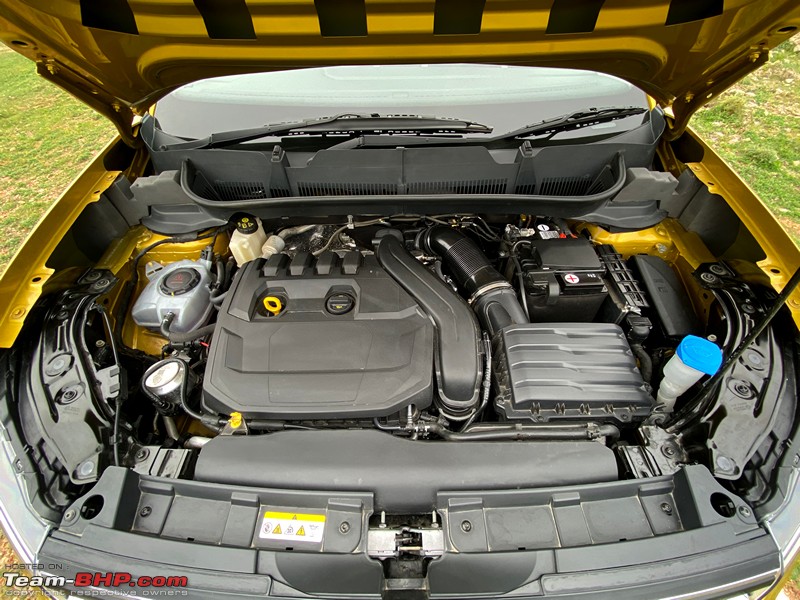 While all variants of the Taigun come with an improved version of the Polo's 1.0L, 3-cylinder TSI engine, mated to a 6-speed manual transmission (MQ200) and some have a 6-speed torque-converter AT too (AQ250), the top-end GT variants also get the 1.5L, 4-cylinder TSI engine, which was used in the T-Roc. It is matched to a 6-speed MT (MQ281) and a 7-speed DSG (DQ200). The engine produces 148 BHP & 250 Nm. This makes it more powerful than the Korean twins' 1.4L turbo-petrol (138 BHP & 242 Nm), but not the Duster 1.3L's 154 BHP & 254 Nm. There is no diesel engine on offer. It's very sad that VAG has decided not to make its brilliant 1.5L TDI BS6 compliant. Those with high usage will be disappointed, especially with petrol now costing over 100-bucks a litre! Internationally, the T-Cross is also available with a 1.6L TDI motor that produces 94 BHP and 250 Nm. Throttle response is satisfactory and the Taigun rolls off without a fuss. Once on the move, the 1.5 TSI provides good driveability. The motor can pull from as low as 1,000 rpm, although it's more comfortable above 1,200+ rpm and alive above 1,500. The bottom end is good, because of which, the car didn't even break a sweat climbing a gradual incline on the 4-lane highway in 6th gear at 60 km/h. Importantly, this engine pulls much better than the 1.0 TSI from low revs. At the end of the day, you can't argue with displacement and this is 50% bigger in size than its smaller sibling. Downshifts aren't required frequently. The light electric steering, compact size of the car, taller seating, good ergonomics and excellent frontal view make the Taigun superb to drive in the city. Out on the open road, the power on tap makes the 1.5 TSI a fast performer and a whole lot of fun. VW says it'll do 0 - 100 in 9.1 seconds on a good day and we totally buy that (Skoda claims a significantly quicker 8.6 seconds for the Kushaq!). However, it doesn't have that crazy streak of the 1.0L. While the smaller 1.0 TSI is wild and begs to be driven hard, the 1.5L is more mature with its power delivery. This 1.5 TSI employs a long stroke configuration compared to the near square nature of the 1.0 - think of the 1.5L as the grownup bigger brother to the mischievous brat 1.0 TSI. Even torque steer is extremely well-controlled for a 148 BHP FWD car. The 1.5L TSI is very tractable and pulls cleanly. Driving it on the highway is an addictive experience and you will find yourself driving fast, even if you didn't intend to. To overtake, just drop a gear and floor it...the strong mid-range will ensure you fly past the slower vehicle. The engine revs in a linear fashion till ~6,600 rpm. In terms of cruiseability, the Taigun can run at triple-digit speeds all day long without breaking into a sweat. The TSI spins at a relaxed ~2,000 rpm at 100 km/h in 6th gear, and just a notch below 2,500 rpm at 120 km/h. Beyond 5,000 rpm, however, the engine starts getting a bit boomy. Summary = this is overall a fast, smooth & lovable engine. Enthusiasts will relish the MQ281 6-speed MT. It is slick, with short throws and well-defined gates. The gears are closely stacked together (try shifting from 4th to 5th and you'll see). The clutch, though light, is quite springy and you need to carefully modulate it in stop-and-go traffic to avoid stalling the car. Its travel range is longer than we'd like too. This trait of the clutch gets irritating in bumper to bumper traffic. Driving the Taigun 1.5L DSG AutomaticThe 1.5L engine also comes with the fast & smooth, but notorious 7-speed DQ200 DSG gearbox: 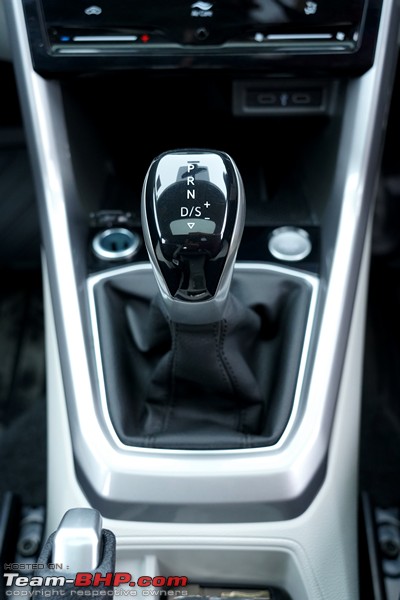 I must say this - as fun as it was to drive the manual, the 1.5 DSG, to me, was the perfect engine-gearbox combination for the Taigun. Fast and effortless at any legal speed, the powertrain compliments the ride and handling characteristics of the car beautifully. The combo makes the Taigun an effortless cross-country mile-muncher, if fuel prices are not a concern  . .Slot into D mode, take your foot off the brake pedal and the Taigun slowly creeps forward at ~5 km/h. This behaviour will be highly appreciated in city traffic conditions. It is quite unlike the 1.0 TSI AT (as per my experience with the Polo), which feels more aggressive. Drive with a light foot and the gearbox moves up the ratios pretty quickly. Impressively, you won't feel these shifts as the transition is very smooth. While the automatic transmission makes the Taigun very easy to drive in the city, when crawling in slow traffic (1st - 3rd gears), you will experience a little jerkiness, which is a typical DSG trait. Under harsh sunlight, the display on the gear selector isn't bright enough, but the virtual cockpit shows the mode as well as the exact gear engaged (in M, S and even D modes). In the city, the 1.5 motor's healthy bottom end helps you get around effortlessly. Throttle response is good and the Taigun moves smoothly. Add to that, the direct injection and turbocharger ensure that the engine isn't lethargic at any speed. There's always enough power on tap to accelerate or overtake quickly. Out on the highway is when things go from good to great! This is easily among the most fun-to-drive crossovers for 2 million bucks. You'll find yourself addicted to flooring the throttle whenever there's an empty stretch of road. Outright performance is excellent and the strong mid-range takes care of all the overtaking you need to do. The downshifts are quick (not as fast as upshifts though) and the gearbox responds well to throttle inputs. The 7th ratio gives the Taigun DSG long legs on the highway. And touring you must do - this car is built for long road-trips. In summary, the 1.5 TSI DSG is a jewel of a combination that will keep you happy at low revs & high, and in the city as well as on the highway. Other than its reliability woes, this is one of the best AT gearboxes sold in India. I found the 1.5L TSI to be too boomy at high revs though. If you are continuously driving hard and / or in ‘S” mode, your passengers will complain about the prominent boominess. It is part motor, and part compromised insulation levels. The sound gets very annoying if you are driving aggressively for a longer duration. Tap the left paddle for a downshift and manual mode is engaged. The ECU blips the throttle to match the revs, and holds the gear till near the redline. This gets addictive, especially during overtakes! However, even in manual mode, the DSG will upshift above ~6,000 rpm and also downshift below ~1,000 rpm. We feel this is way too conservative - the MT revs to ~6600 rpm. Manual mode will also ignore wrong gear selections which put the engine out of the above rpm ranges. Long hold the paddles to revert back to auto mode. Cruising around in D mode, one won't even notice the gears being shifted. They are damn smooth. The kickdown response time is quick enough and you will never feel that the gearbox is hunting for gears either. It's in the right ratio almost all the time. When you are in the mood to drive the car aggressively, engage Sport mode. In S, the gearbox downshifts to keep the car in the power band, holds the ratios longer and lets the punchy midrange do all the heavy lifting required. Out on the open road, you will find it hard to resist the urge to go hard on the throttle. The Taigun is simply brilliant to drive! Cruise control works seamlessly with the automatic transmission. After slowing down from a 100 km/h cruise to stop at a toll booth, we hit 'resume' just after and the car smoothly accelerated from around 10 km/h to the ton. On the flip side, we have scarily serious concerns over the DSG's long-term reliability. Just search on Team-BHP and you will see story after story of DQ200 failures & breakdowns. VW insists they have fixed the problem, but we aren't convinced at all. This gearbox has inherent design defects IMHO. Some BHPians who can't resist the DSG have mentally relegated themselves to 2 breakdowns over 8 - 10 years of ownership. Noise, Vibration & Harshness (NVH)The 1.5L TSI is overall refined. It's a lot smoother than the 1.0 TSI which has some 3-cylinder vibrations, noises, groans & growls. That said, even the 1.5L TSI gets very boomy past 5,000 rpm. We found tyre & road noise at 110 - 120 km/h on concrete expressways / rumble strips to be higher than expected in a car with premium aspirations. On the other hand, wind noise is nicely controlled at expressway speeds. Mileage & Fuel EconomyARAI fuel economy figures for the Taigun have not yet been revealed. Drive the TSIs with a light foot and they should give you acceptable FE. Turbo-petrols are very sensitive to throttle input though; drive it hard and you'll see the tank needle drop fast. VW has given the 1.5L Taigun Active Cylinder Technology. When cruising calmly on the open road, the ECU shuts off cylinders 2 and 3 to reduce fuel consumption. This 2-cylinder mode will lead to good long distance FE, that is if you drive calmly (which is tough in the TSI). While the Taigun GT is generally too much fun to let you see the ACT getting engaged, it really shows up when cruising, especially with cruise control engaged. Setting cruise control at 80 km/h will see ACT engaged predominantly with excellent highway efficiency figures. But that's not all. Even on a long 120 km/h cruise, the cylinders get deactivated on flat ground and at the hint of the slightest slopes. Despite checking to the best of my abilities, I just could not pick up any change in noise or vibrations when the cylinders were engaged or disengaged. It's seamless. When the car is running on 2 cylinders, it's displayed in the instrument cluster: 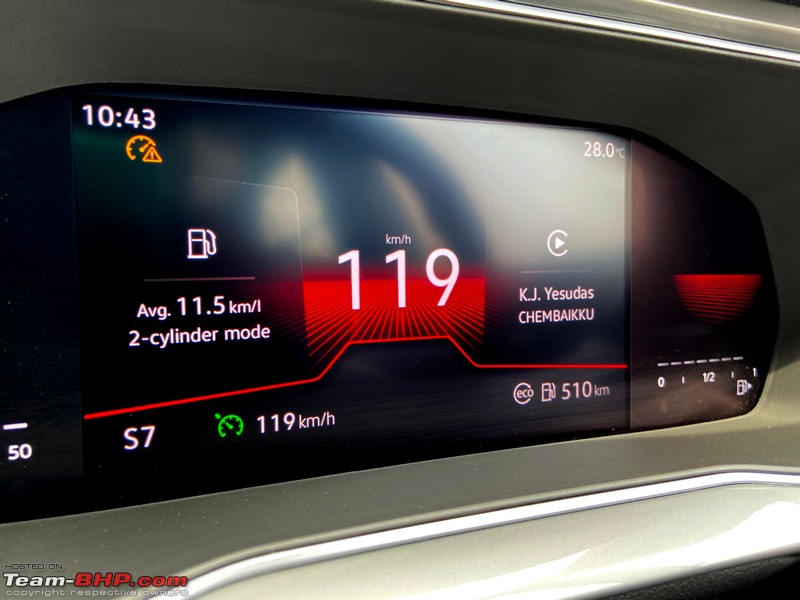 SuspensionVolkswagen officials mention that the suspension hardware, which is the same as the Kushaq, is tuned slightly differently in the Taigun. Although my drive experience with the Kushaq is not as extensive as with the Taigun, I feel that the difference (if any) isn't drastic, which is not a bad thing! In short, the setup is brilliant and will be loved by both, regular drivers and enthusiasts alike. Ride ComfortThe Taigun's ride quality can be termed as mature & compliant. We have to say this is the perfect suspension tune that VW has chosen. It is neither too soft (Hector) nor too stiff (Seltos). Owners will find the ride quality to be endearing. It offers good comfort levels in the city, on broken village roads & on highways alike. For the most part, it does its job in silence, but sharp ruts do find their way into the cabin and that results in an occasional "clunk". This was more prominent in our automatic car with the 17" rims & 33 PSI tyre pressures (verified). The ride quality of the manual variant with the 16" rims was slightly better with lesser noise and a rounded off feel over the sharp stuff. Handling & DynamicsAs expected of a VW, the Taigun has sorted road manners. It has excellent straight-line stability and composure at high speeds. In fact, 120 km/h feels more like 90 - 100 km/h. You can confidently maintain high speeds on the expressway. Driving the Taigun on winding roads was fun, with the front end seemingly eager to turn. Sure, there is body roll, but it's a family crossover at the end of the day. Nothing too alarming, and it takes high-speed expressway curves at cruising speeds without breaking a sweat. The tyres are the same Goodyears used on the Kushaq. Grip levels were fair. Although, for the enthusiast, we would still recommend upgrading to better rubber as these tyres were squealing under hard cornering @ 85 km/h! SteeringThe EPS feels direct & sharp. It is light at parking & city speeds which is now the market's preference. Our complaint is that, at 100 - 110 km/h, it is still a level too light and comfort-oriented for enthusiasts' tastes. We wish VW had firmed things up more for highway speeds. A user-selectable 'Sport' driving mode that stiffens things up would be nice. BrakingWhile its main rivals, the Creta and Seltos, get all-wheel disc brakes, the Taigun makes do with discs at the front and drums at the rear. The brake pedal is well calibrated and feels sharp to use. In fact, we felt that the brakes of the Taigun were more confidence-inspiring than those of the Korean twins. The braking is powerful and we felt confident with them on our highway run. Niggles & ProblemsVW is generally known for expensive maintenance bills and the occasional major breakdown. Truth is, many owners have suffered multiple breakdowns, especially with the DQ200 DSG gearbox. Even apart from the gearbox, don't expect a Toyota or Maruti kind of ownership experience over 5 - 10 years. Take the extended warranty without a second thought, and be sure to get the car serviced on time. For its part, VW is trying to improve its brand image with the Sarvottam 2.0 initiative, and hopefully, there will be maintenance packages etc. announced during the launch, but the dealers are the same, the cars are complicated & the parts are expensive. Those buying the 1.5L MT or 1.0L AT (torque converter) / MT might enjoy better long-term reliability than owners of the 1.5L DSG. A fast and effortless mile-muncher: 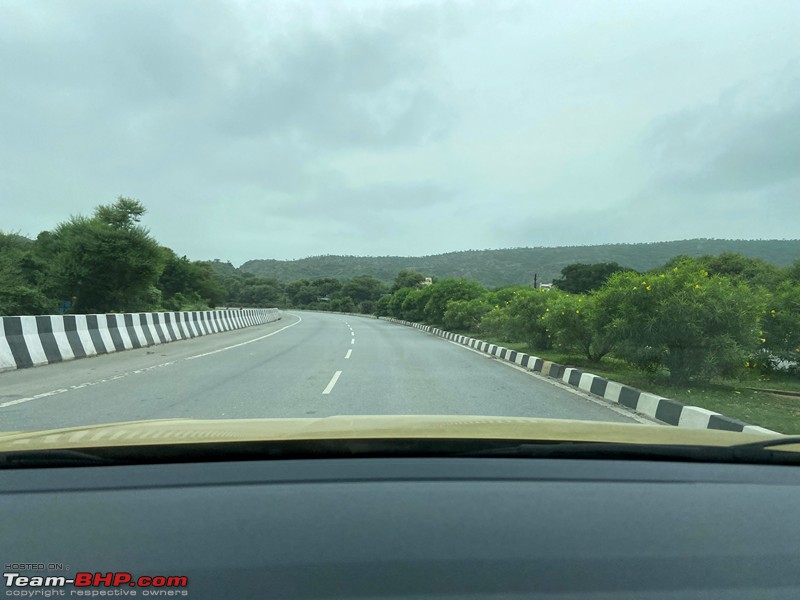 There's no insulation sheet under the bonnet. The motor is generally refined, but more insulation might have helped reduce the boomy nature above 5,000 rpm:  No underbody protection is sad given our road conditions and VW's high repair costs: 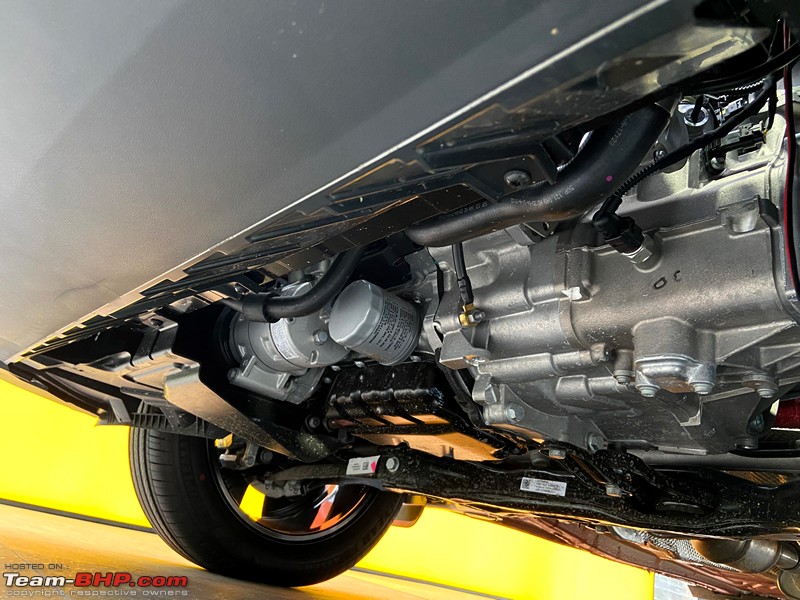 Dual-tone horn sounds effective, but is not the wind tone type generally expected in a VAG car: 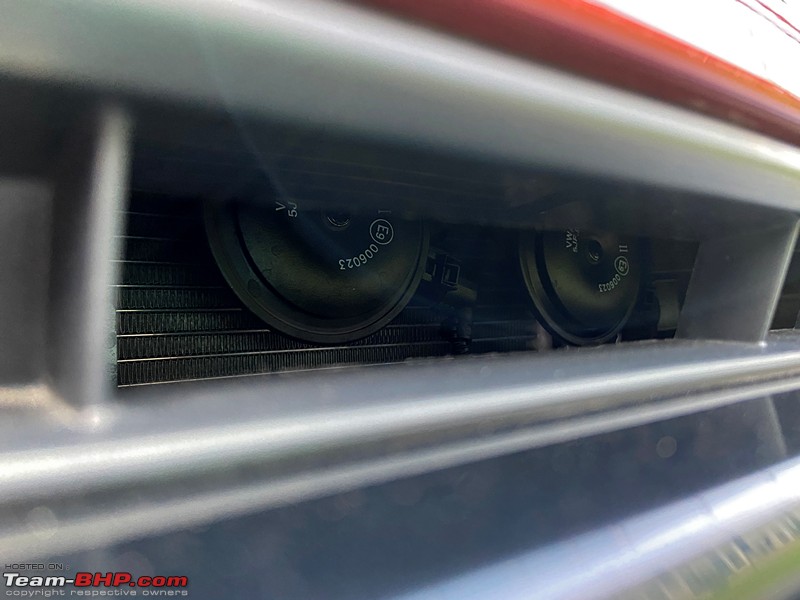 Last edited by GTO : 31st August 2021 at 09:18. |
| |  (74)
Thanks (74)
Thanks
 |
| The following 74 BHPians Thank CrAzY dRiVeR for this useful post: | Aceyadu, Aditya, Akshay6988, amit1agrawal, Anis Ahmed, Arnav Vaghela, ashis89, Autocaptive, Avikbrio, a_chelat, Bibendum90949, CARDEEP, CEF_Beasts, chinmaypillay, deepakhon, deepfreak15, Dr.AD, Dr.Naren, espraveen, Excommunicado, FloatingCanvas, fluidicjoy, Gaboonviper04, Gannu_1, GaryTSI, Geta, GTO, hemanth.anand, igemini, InControl, Jaggu, jazzrockz, jithin23, klgiridhar, LaRoca, lemedico, Livnletcarsliv, lovetorque, Meph1st0, museycal, Mustang Sammy, naadopaasaka, na_agrawal, Nrulz, Osteon206, PraNeel, PrasunBannerjee, RaghuVis, RavenAvi, rednikhil, regenitin, Rehaan, Reinhard, Researcher, Rigid Rotor, saikarthik, sam2007$, Samba, sangam_mm93, searacer932, shipnil, SoupRaw, t3rm1n80r, The_Outsider!, TorqueIndia, Varun_HexaGuy, vb-saan, vbd316, Venkatesh, Vik0728, VivekCherian, vivekn83, vvrchandra, Xaos636 |
| | #3 |
| Team-BHP Support  | Volkswagen Taigun Exterior ImagesFront is unmistakably VW (OK, the chrome is an obvious elephant in the room and we'll discuss it later). This is the first product from the company's India line-up to sport the brand's new logo (in case anyone is wondering how to easily identify the new logo, the 'W' doesn't touch the circle anymore). Seen here is the Taigun 1.5 GT DSG in the top-end trim and painted in bright Curcuma Yellow...  ...and the GT 1.5 TSI manual in the mid-spec trim, finished in Wild Cherry Red:  The rear too is very "VW", but as with the front, it is spiced up for the Asian markets. Horizontal end-to-end design elements lend the car a wider and more planted stance:  It is from the sides that one will truly appreciate these classic VW lines. Notice the crease that emerges from the front GT badging and merges with the tail lamps:  While we await the official information regarding the dimensions, it has been revealed that the wheelbase of 2,651 mm is unchanged from the Kushaq. Dimensionally, the Taigun is smaller than its main rivals, the Creta and the Seltos, but it has a longer wheelbase (the Korean twins have a wheelbase of 2,610 mm). Small size doesn't give it much street presence: 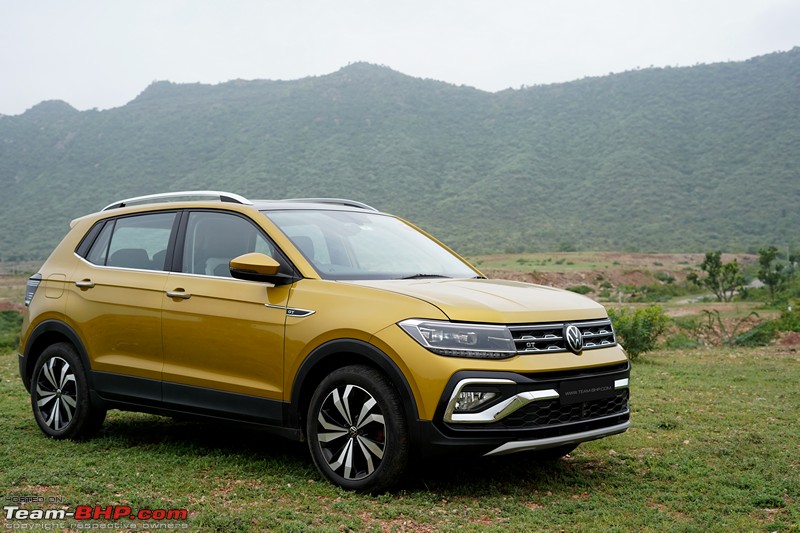 Since the Taigun doesn't need to stick to the sub-4m rules, the bumpers protrude on either side. This should help protect the metal work in city driving conditions where minor altercations happen, and gets a thumbs up from us:  Smart all-LED headlamp clusters on the top variant consist of daytime running lights, LED projectors for the low beam & main beam and LED turn indicators (not dynamic/sequential type). Unconventionally large halogen foglamps sit below the headlights and come with a cornering function:  A look at the smart detailing inside the headlamp cluster. No branding here: 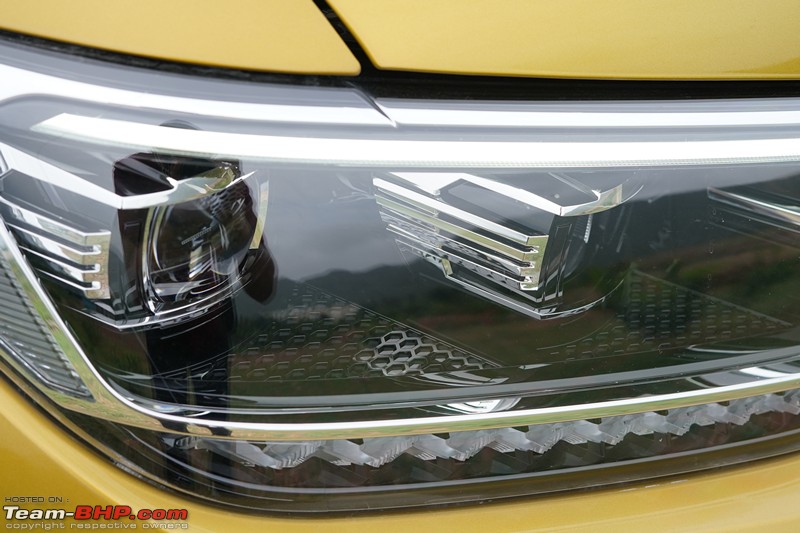 DRLs are bright and prominent, even during the day:  1.5 GT Manual comes with halogen headlamps. LED daytime running lamps sit at the bottom of the cluster with halogen indicators on the sides: 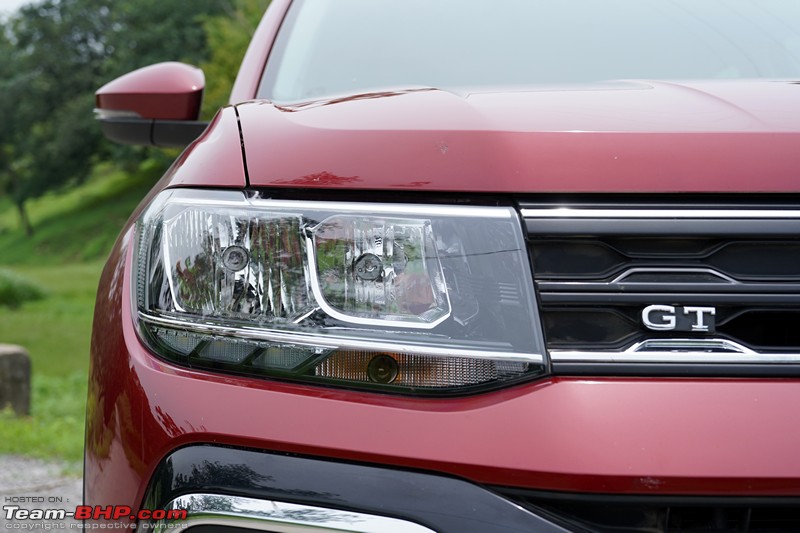 Bonnet has subtle character humps and ends sharply at the front. The signature VW grille looks good & has a three-layer chrome lining on the top-spec variants: 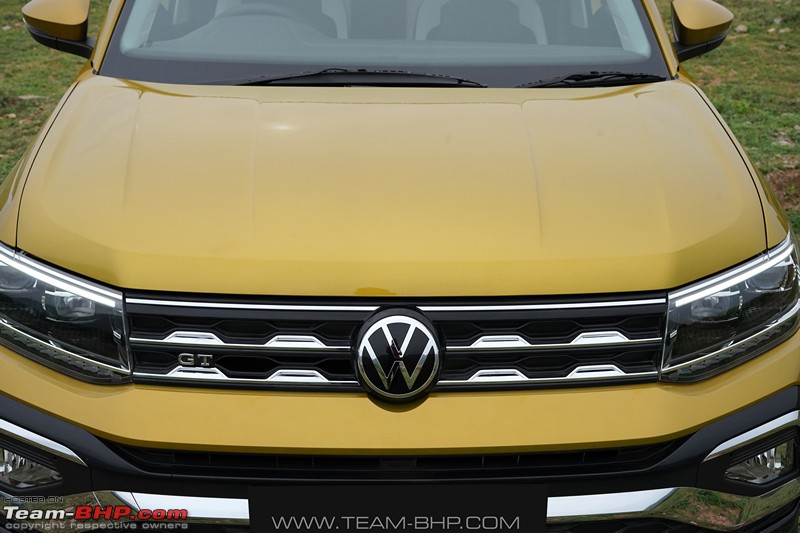 1.5 GT Manual variant in the lower spec trim receives a slightly different grille, with less chrome. Same is the case with lower trims of the 1.0 TSI as shown here: 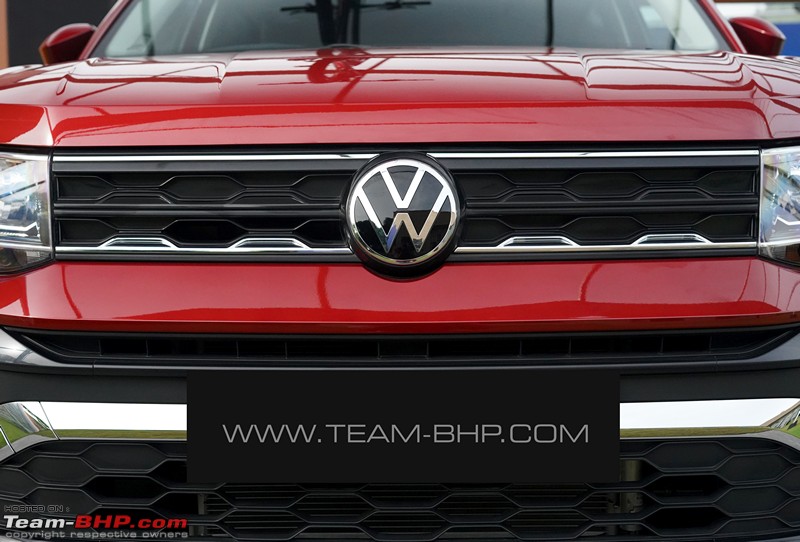 Time to address the elephant in the room - the generous use of chrome upfront. As mentioned earlier, this has probably been done based on market feedback - the Chinese market more so - even though ours loves chrome as well! 'Chrome delete' will be a popular mod with BHPians. Front bumper features a wide air dam with a black honeycomb mesh grille with a faux silver skid plate below for that 'SUVW' stance. But seriously, that garish chrome! It's as if the Taigun went jewellery shopping just before its unveil: 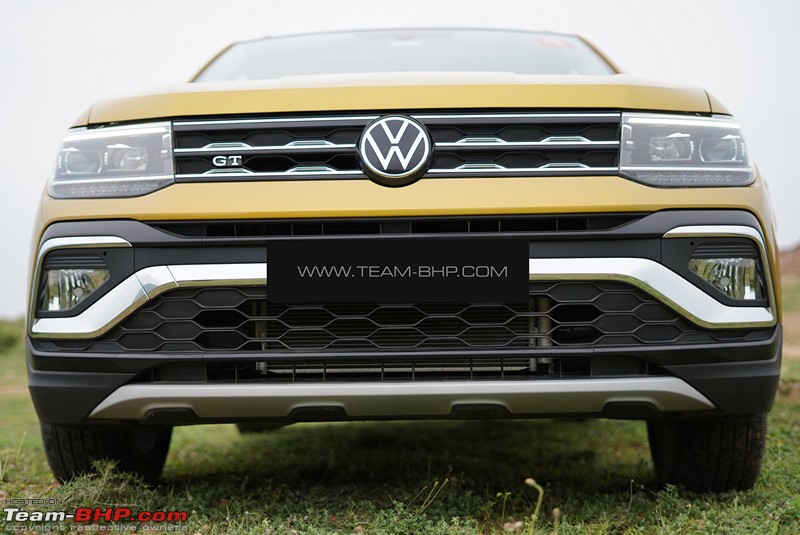 Rain-sensing wipers have their spindles & washers tucked under the bonnet: 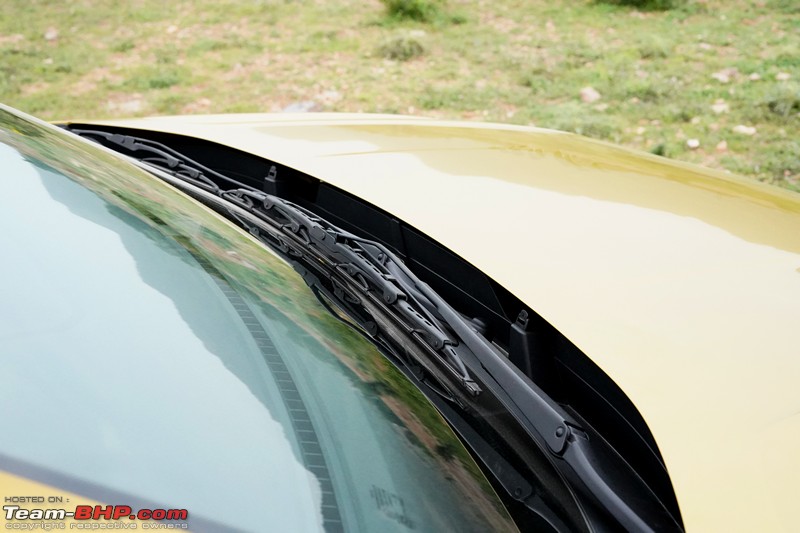 1.5 TSI variants sport unique piano black panels with chrome "GT" lettering. I find these tastefully done, whereas Gannu preferred a cleaner look to the fenders. No such badges for the 1.0 petrol:  ORVMs with integrated blinkers and auto-folding function. This setting can be changed from the infotainment unit: 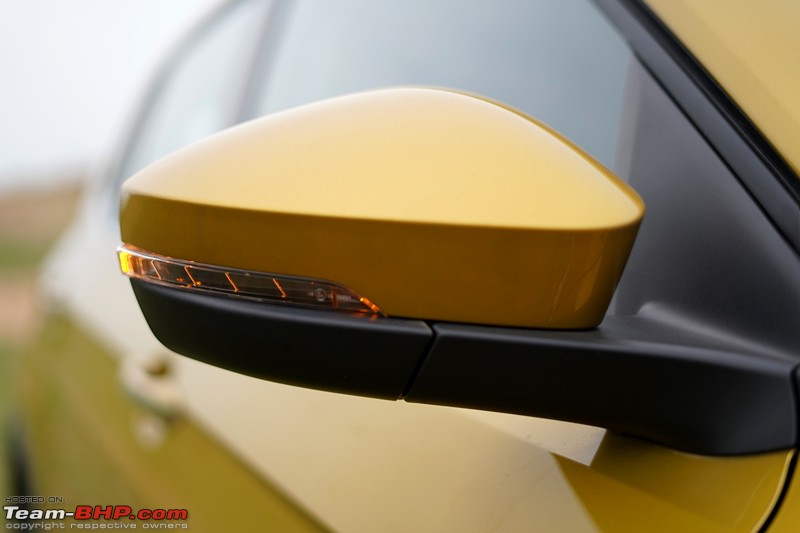 Subtle 'Volkswagen' branding on the B-pillars. On the top-end variants, the pillars are finished in gloss black and sport chrome inserts on the door handles, with request sensors on both front doors: 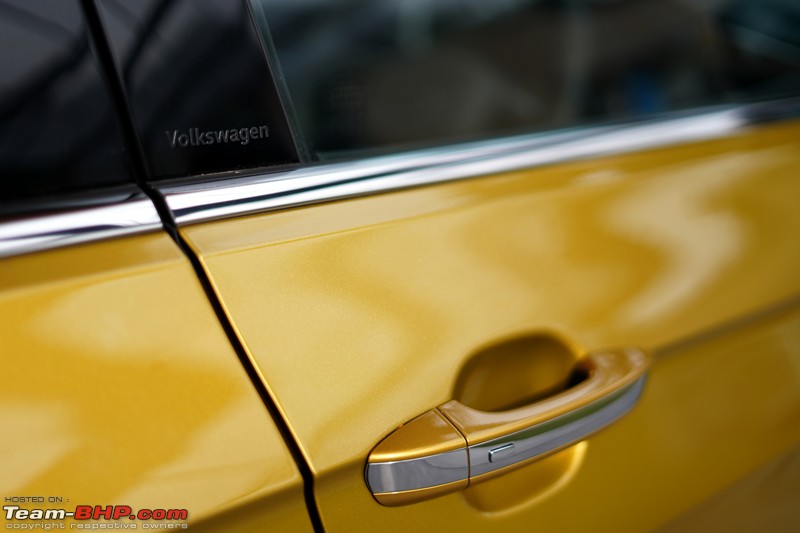 On the lower trims (like the GT Manual pictured here), the pillars are finished in matte black. They miss out on the chrome window belt line and also the chrome inserts on the door handles:  In the lower variants, the driver side door handle doesn't get request sensors (key slot is probably hidden behind the plastic cap on the left)! Looks neat and we love it from a design perspective. So clean & pure: 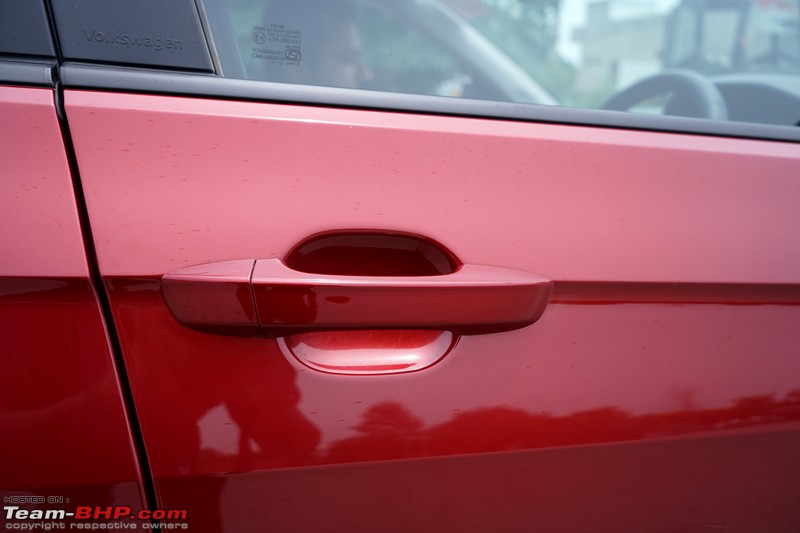 Roof slopes down towards the rear, while the window line rises. It starts rising sharply just before the C-pillar to form a nice kink: 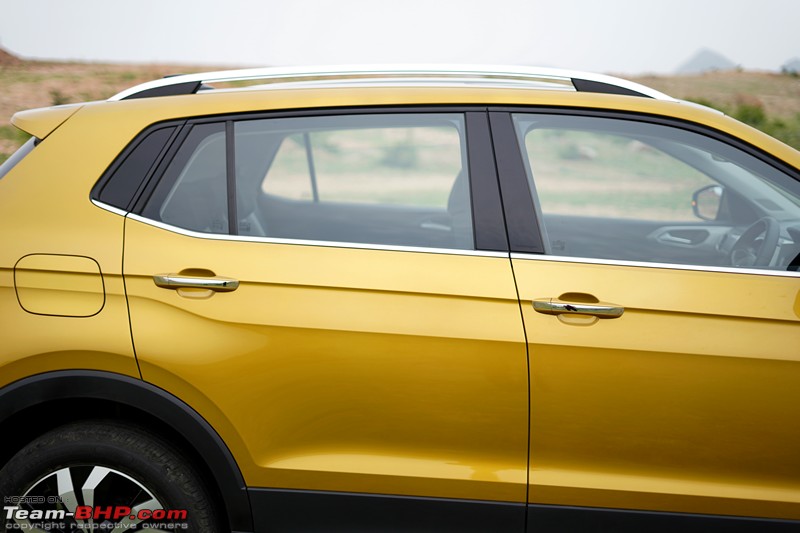 That's not a quarter glass on the C-Pillar, but merely a piano black filler giving a glass-like effect. Also note the subtle design difference in the chrome element VW has adopted for the Taigun as compared to its cousin: 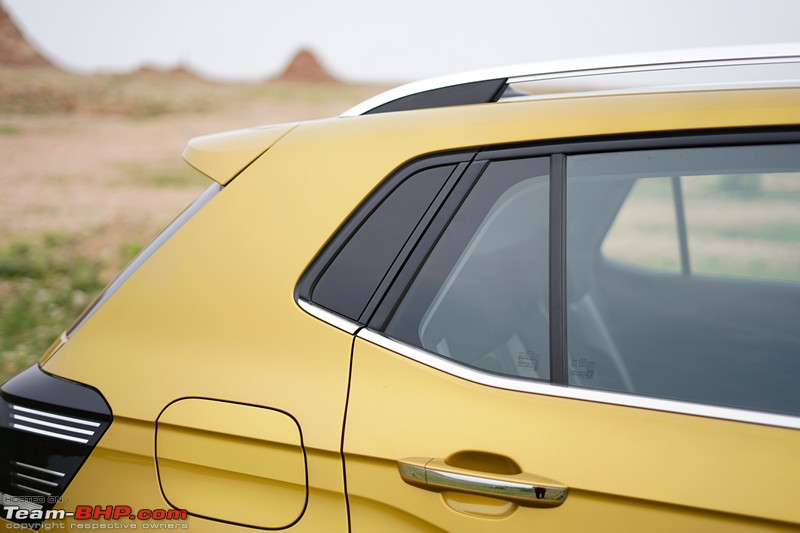 Lovely cuts & creases, done in a classy manner accomplished only by the German brands: 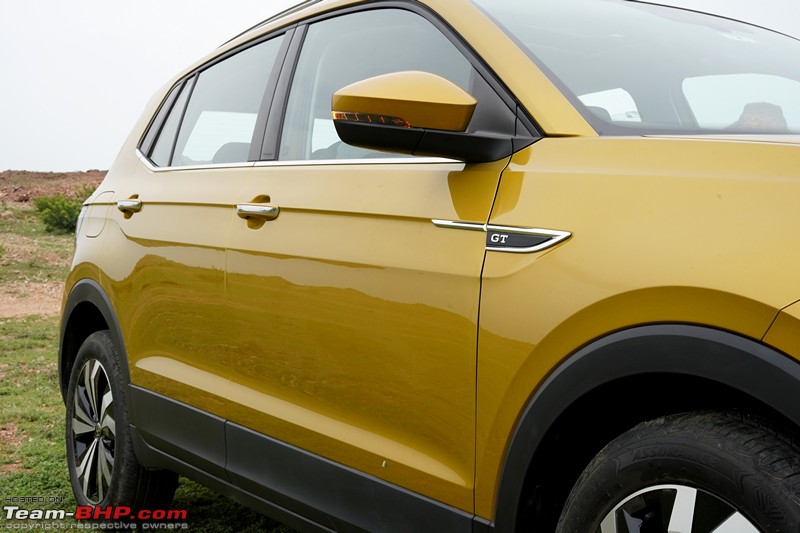 Subtle crease runs low on the doors. Black plastic cladding for that "crossover" stance: 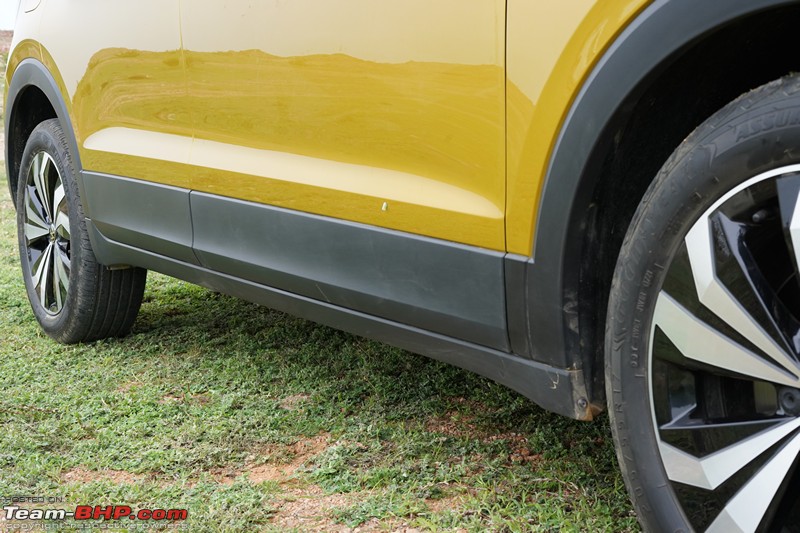 17" 6.5J Manila alloy wheels of the top-spec trim shod with 205/55 section Goodyear Assurance Triplemax 2 tyres fill up the wheel wells nicely. These alloys are diamond cut and have an 'aero' element when seen closely. While some markets have the option of custom coloured 'Manila' wheels on the T-Cross, BHPians would agree that we fancy these good old monochrome ones more than orange and green! That said, don't miss those sweet red brake calipers on the top-spec GT DSG trim:  It's the top-spec 1.0 TSI trims that receive the best alloys IMHO! Once again, 17" and shod with 205/55 section Goodyear Assurance Triplemax 2 rubber: 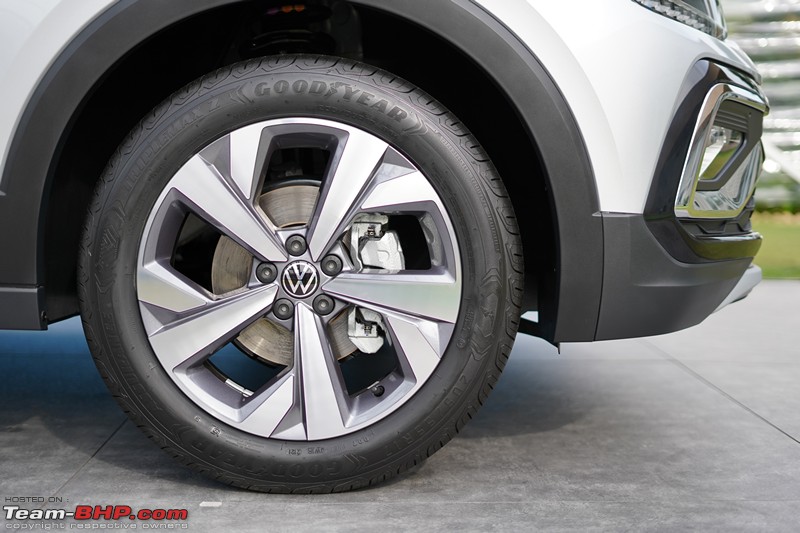 GT manual variant gets 16" Belmont alloy wheels shod with 205/60 section Goodyear Assurance Triplemax 2 tyres. Looks very characterless, but this 100 PCD setup should provide a lot of upgrade options. The 16" cars should ride cushier than the 17" ones: 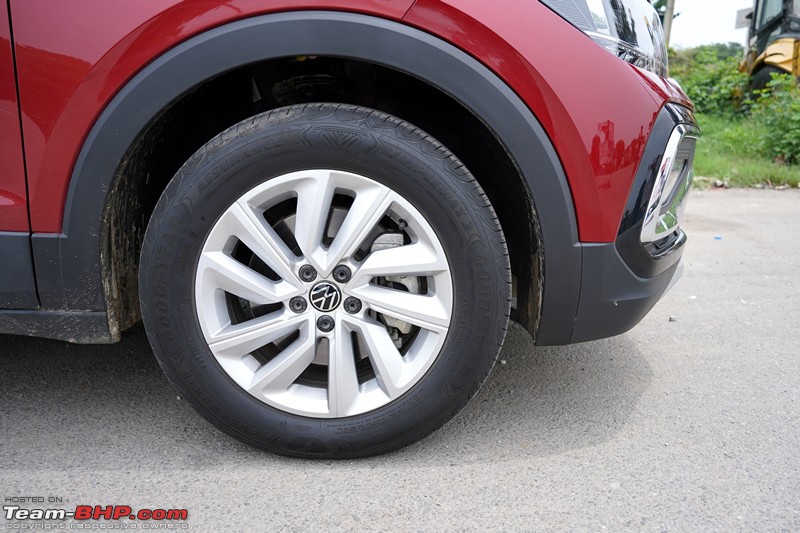 Even the fast 1.5L variants do not get rear disc brakes. Still, braking performance is strong and reassuring:  Full plastic cladding in the front wheel well... 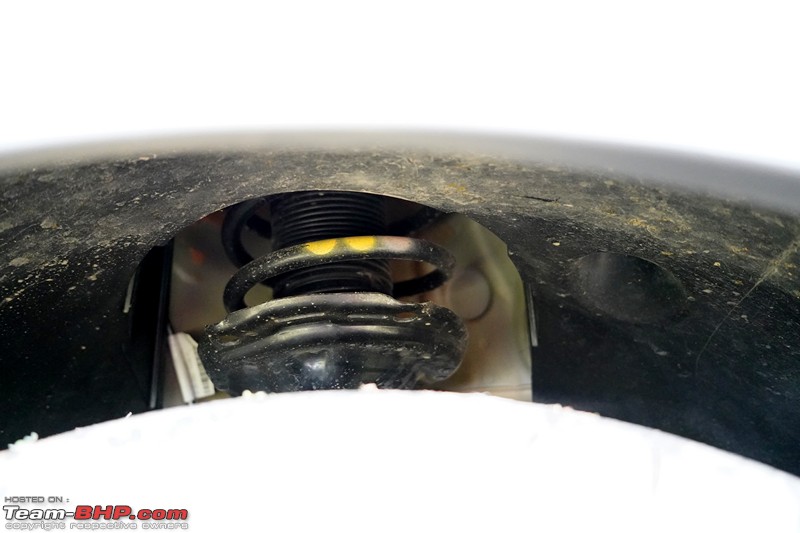 ...as well as the rear: 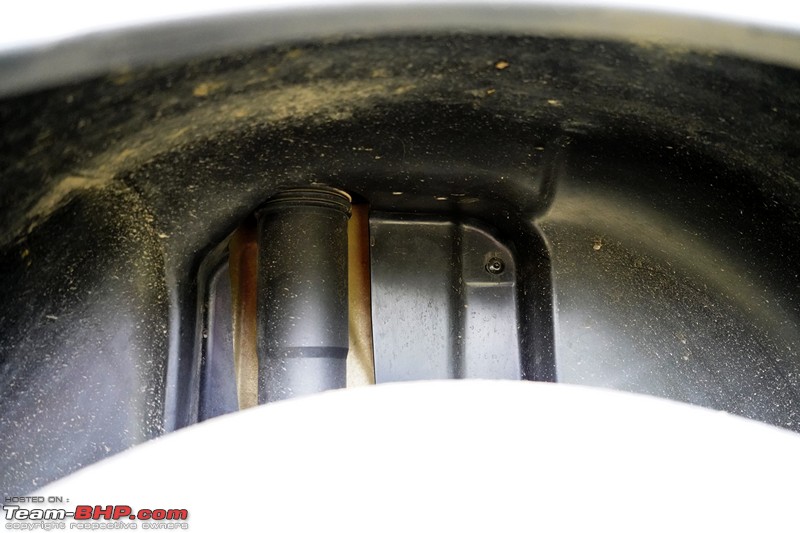 Silver roof rails enhance the vehicle's crossover appearance. Top-end variants get a contrast black roof and a fair-sized regular sunroof, but not a panoramic unit like the Creta's: 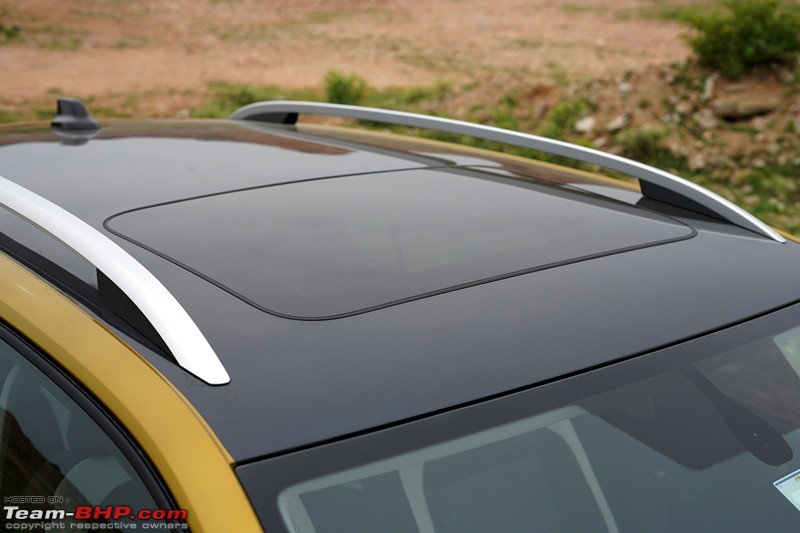 VW provides functional roof rails. To prove this point, they even had a display Taigun with a bicycle rack on top. Sweeeeet attention to detail - that's not just any bicycle, but a 2021 VW GTI hardtail mountain bike: 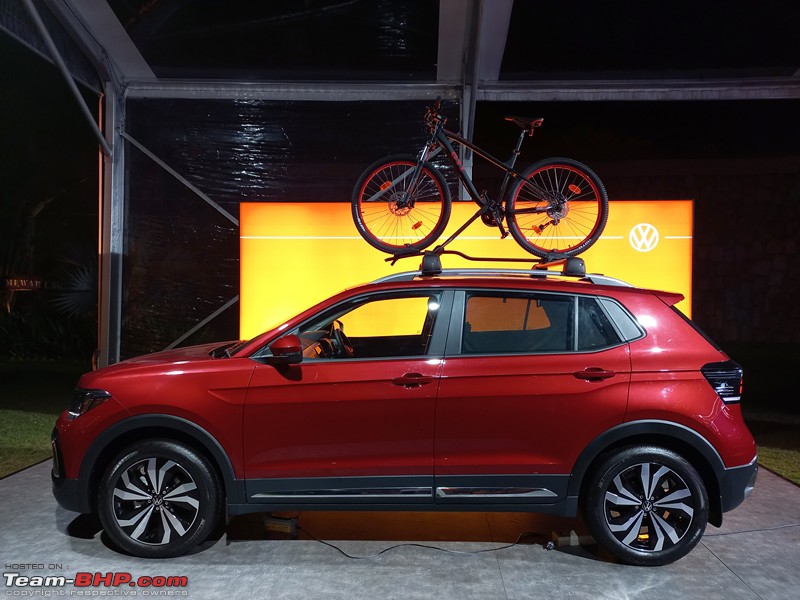 Rear spoiler is a two-piece unit with a metal portion on the inside and a plastic portion on the outside. The two portions are separated by a crease, very evident on this dual-tone colour scheme. Black sharkfin antenna sits at the end of the roof section: 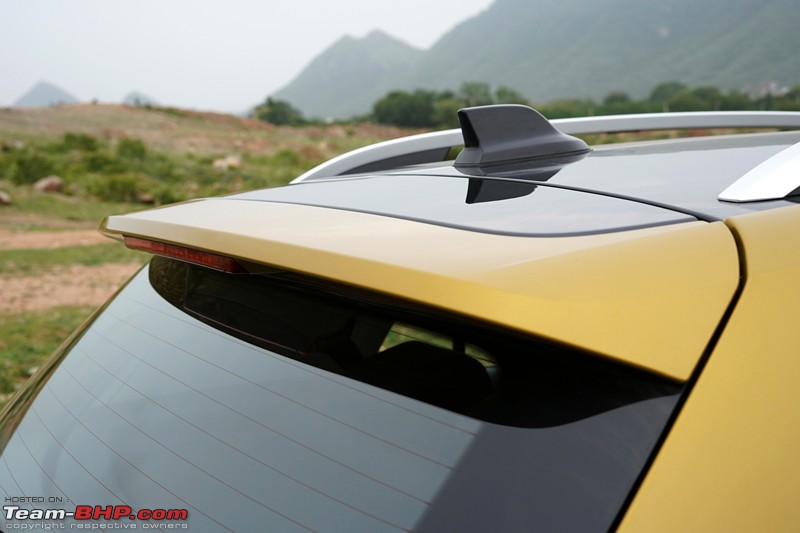 Infinity LED tail-lamp cluster stretches end-to-end and provides a distinct / funky visual identity to the Taigun. Looks very Audi’esque. They get black outer diffusers with chrome elements on the sides to break the monotony. The Taigun does not get rear fog lamps: 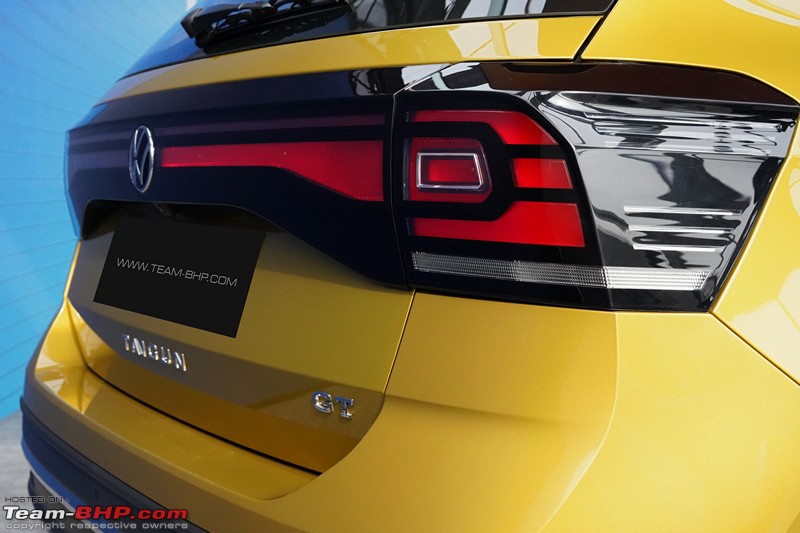 A closer look at the "love it or hate it, but can't ignore it" detailing: 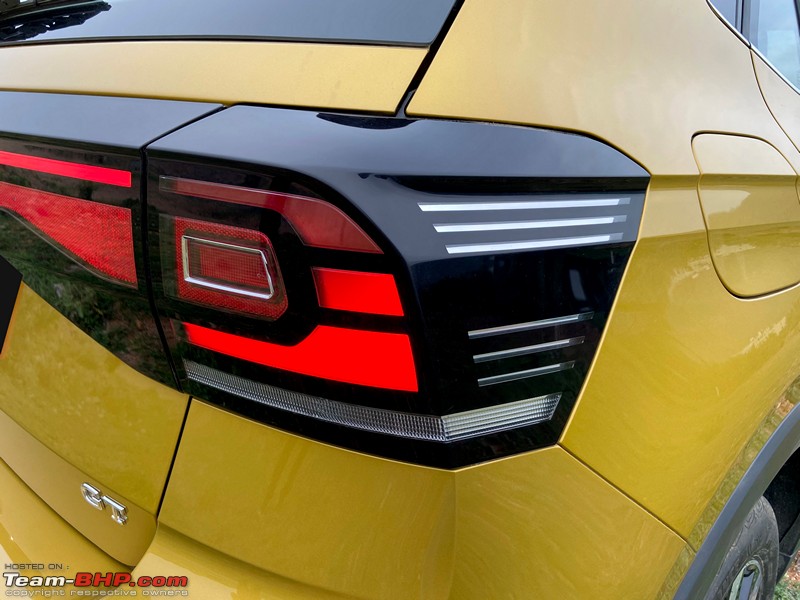 Looks more appealing once darkness falls: 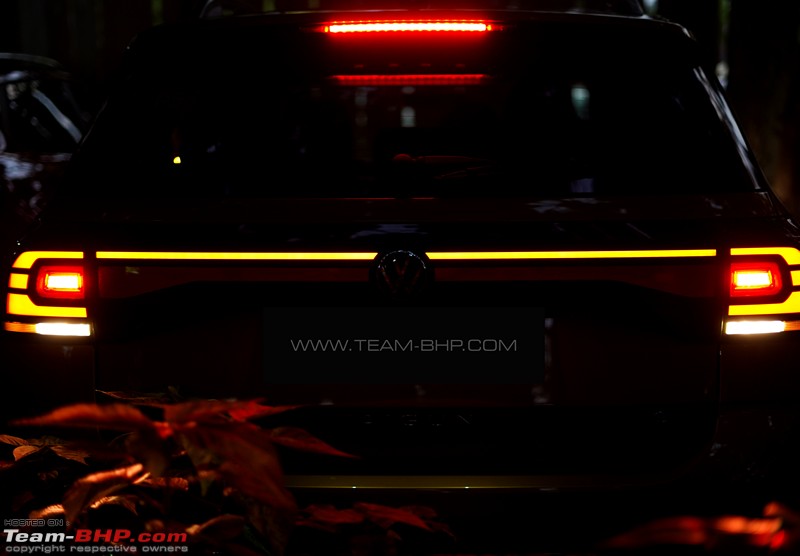 Large reflective strip underneath, shines like a gigantic neon board! Those following a Taigun won't mistake it for any other car: 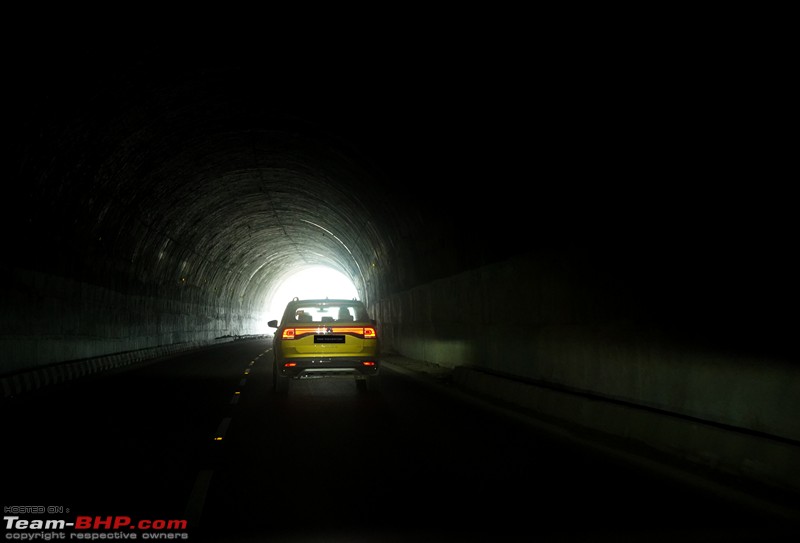 Ugghh! The conventional, frame-type wiper looks so damn ugly and out of place on this car! Oh come on VW, even the old Polo gets a neat, frameless wiper! Windscreen washer sits up, to the RHS of the high mounted stop lamp: 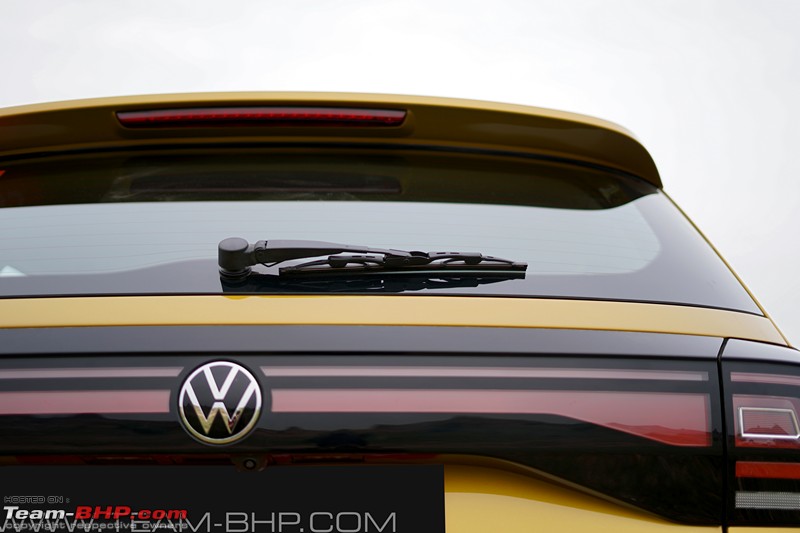 Higher variant gets a reversing camera which is placed next to the electromagnetic boot release. It provides a poor quality feed and does not support dynamic guidelines - both points are unacceptable in the segment: 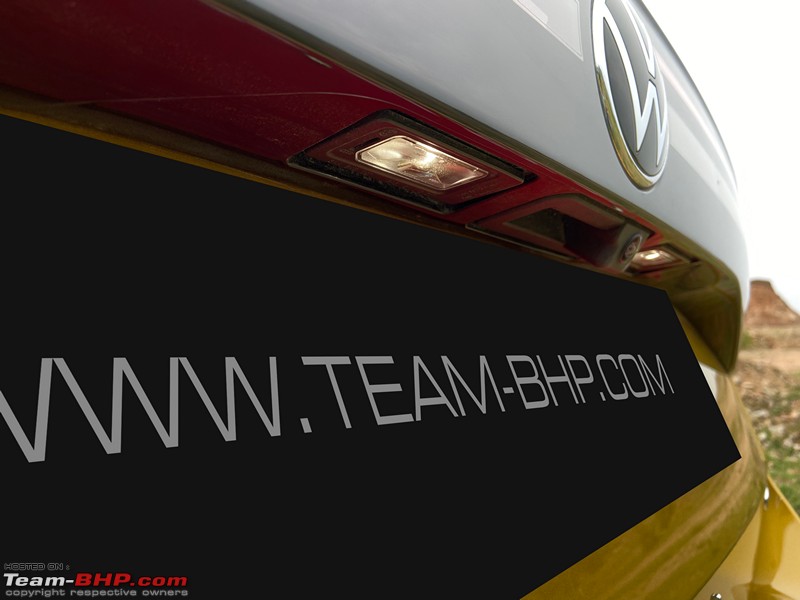 Taigun branding placed centrally with smart fonts. GT badge of the 1.5 TSI variants lets other road users know why its harder to catch up with this crossover than the rest:  Thick chrome bar (ugghh) at the rear as well, surrounding a fake silver skid plate. 3 parking sensors have been provided, while slim reflectors sit higher on either side: 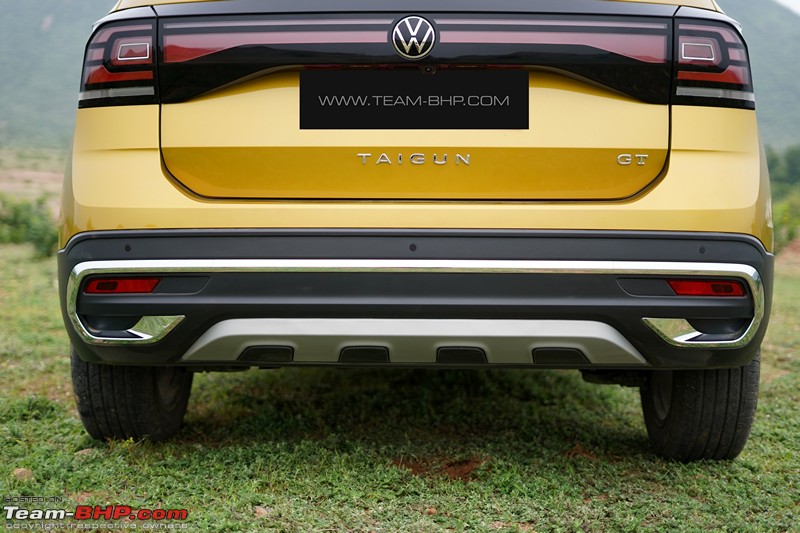 Twin exhaust pipes on the left:  While all the cars in the test fleet were painted in the signature colours of Curcuma Yellow and Wild Cherry Red, a display car showcased the Reflex Silver option. I'm not a fan of silver, yet will admit that it looks good on the Taigun. Actually, most VWs look hot in silver, thanks to the brand's design lines:  Last edited by GTO : 17th September 2021 at 07:43. |
| |  (67)
Thanks (67)
Thanks
 |
| The following 67 BHPians Thank CrAzY dRiVeR for this useful post: | Abhinav_2502, Aditya, Akshay6988, Anis Ahmed, Arnav Vaghela, ashis89, ashking101, Autocaptive, Avikbrio, a_chelat, CARDEEP, CEF_Beasts, chinmaypillay, Deadpool, deepfreak15, Dr.AD, FloatingCanvas, fluidicjoy, Gaboonviper04, Gannu_1, Geta, GTO, Harjot37, hdman, hemanth.anand, InControl, Jaggu, jazzrockz, jithin23, klgiridhar, lemedico, Livnletcarsliv, lovetorque, museycal, naadopaasaka, na_agrawal, Nrulz, Osteon206, PGNarain, predatorwheelz, RaghuVis, RavenAvi, regenitin, Rehaan, Reinhard, Researcher, Rigid Rotor, rj22, saikarthik, sam2007$, Samba, sangam_mm93, searacer932, shipnil, SoupRaw, t3rm1n80r, The_Outsider!, TorqueIndia, Varun_HexaGuy, vb-saan, vbd316, Venkatesh, Vik0728, VivekCherian, vivekn83, vvrchandra, Xaos636 |
| | #4 |
| Team-BHP Support  | Volkswagen Taigun Interior ImagesGood-looking dashboard with large, gloss painted (red & grey) inserts running from end to end. There are no soft-touch plastics, but the cabin does feel well built:  The windscreen is big and the seating position is somewhat high. This means one can get a very clear view of the road ahead, with taller drivers getting a clean view of the bonnet too. On the downside, we feel that the high-set dashboard will bother shorter drivers in terms of visibility:  The new VW steering wheel debuts in India with the Taigun and feels good. Both the mid and top-spec variants get a leather-wrapped steering with a satin finish trim, but the material selection is different. Choose your everyday view wisely, for there are a few combinations on offer. Here is the GT DSG top-end with gloss grey dashboard inserts, perforated leather for the steering wheel and a red GT theme for the instrument console:  Thinking of ordering your GT in red? Get matching red painted inserts for the cabin as well to go with the red theme of the center console. Note the missing perforated leather and cruise control buttons in the manual transmission variants:  Step into one of the 1.0 top-end trims and you miss out on the perforated leather for the steering wheel, but you do get a nice shade of blue for the instrument cluster:  GT variants get attention-grabbing red ambient lighting that adds to the sporty feel of the cabin. It goes well with the painted cherry red inserts of the red car:  1.0 TSI variants get white ambient lighting, as in the Kushaq:  LHS buttons are for cruise control commands (there are also volume controls down below), while the ones on the RHS are for the virtual cockpit (along with the change tracks below). Eagle-eyed BHPians will be intrigued by that innermost button on the LHS side, as we were, only to be greeted by a 'button without function' warning message on the cockpit  . Who says Germans don't joke? . Who says Germans don't joke?  Left stalk houses light / indicator controls and on the right is the wiper stalk. The Taigun is equipped with auto wipers which are on by default:  Unlike in the Kushaq, the engine start button is located just ahead of the gear shifter:  Old school, classy, conventional dials on the lower variants of the Taigun, including the 1.5 GT Manual. The buttons to check the service interval, set the time and display the trip meter are the same as the ones used in the Polo: 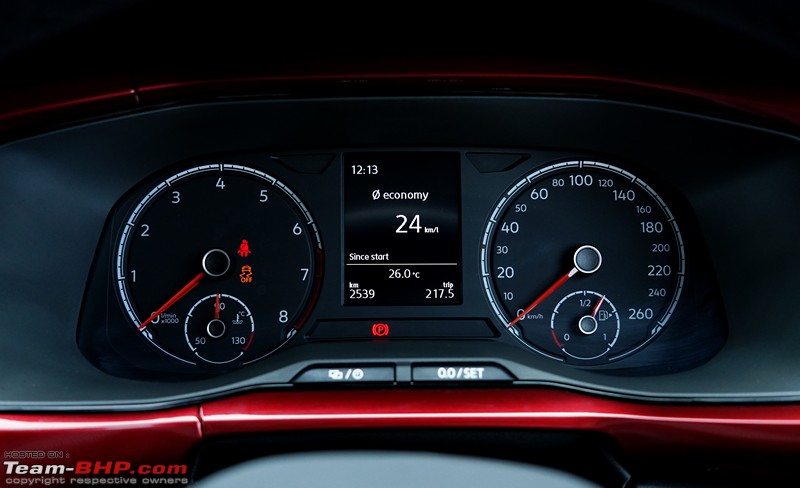 Dials backlit in white and sporty red backlit needles feel more timeless as compared to the ones on the Kushaq. Analogue fuel and temperature gauges have been provided too:  The much-hyped "virtual cockpit" makes an appearance on the higher variants. Looks brilliant at first glance:  But soon, you realize that we don't get the full deal. The 8-inch virtual cockpit provided here instead of the full fat 10-inch unit means that the cluster just isn't wide enough and can only display either the speedo or rpm dials. Not both! Backlit blanks on either side only to complete the visual package:  And the rpm view:  There is also the option of a full-digital console, where either end can be customised to display the parameter you require. These parameters include average speed, gear display, oil temperature, audio, telephone, economy, average economy, distance / time, etc:  The MID also shows the exact door which is open. It covers the tailgate and bonnet too (great to see as the bonnet is skipped by 99% of cars out there): 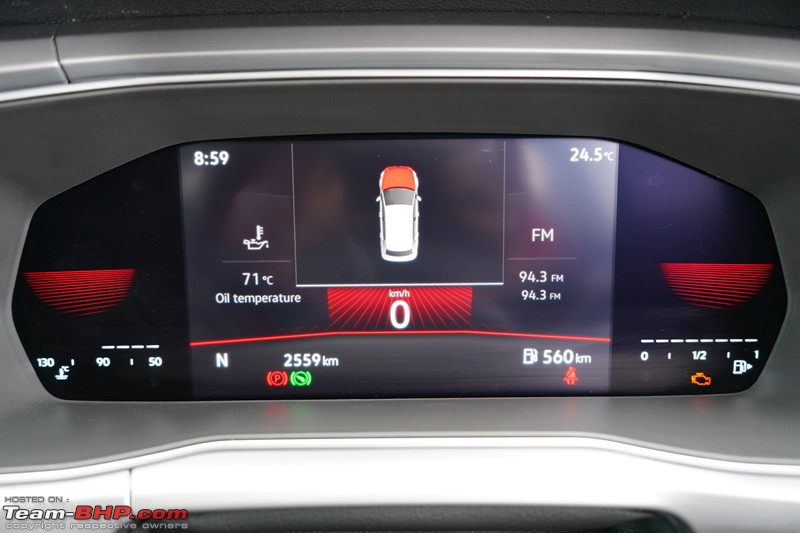 Conventional a/c vents as compared to the Kushaq feel sturdier and, we feel, should receive much less criticism:  Typical European headlamp and foglamp controls. The Taigun gets automatic headlamps on the top spec variants. All-black knob here looks too basic & cheap. We would've liked some silver metal highlights or bordering:  Bonnet release is located on the right of the footwell:  Door pads are mostly black with a small grey portion, and a painted grey insert around the chrome door handle. This looks very boring & plain Jane to our eyes (check out Kia's more interesting approach here & here). The armrest is wrapped in leather, but not all that soft to rest your elbows on longer journeys:  The usual set of backlit window and mirror controls. Driver's window gets auto up & down with an anti-pinch function. We also found this plastic panel to be low rent:  Wide door pockets can hold a lot more than just a water bottle:  A slot to put in longer items, such as an umbrella:  Branded aluminium scuff plates provided: 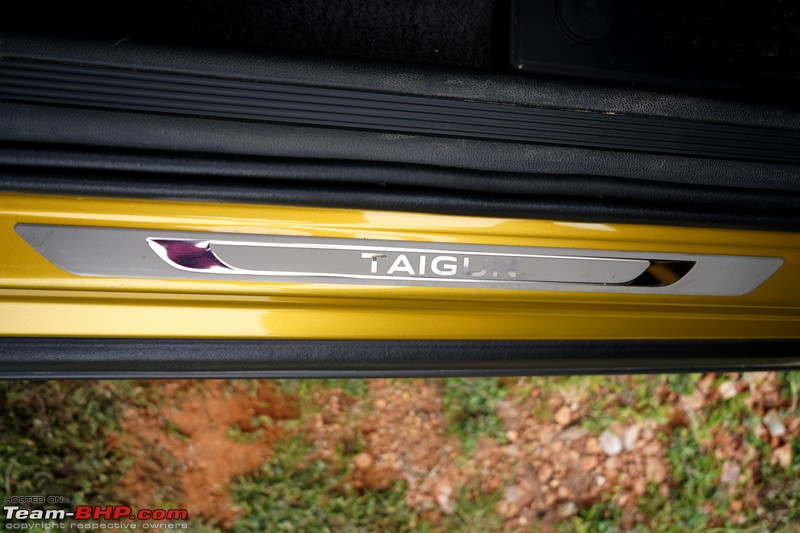 GT variants miss out on ventilated leather seats; imagine how customers paying more money don't get this super useful cooling feature. That said, Volkswagen has better fabric options than Skoda across the range. Center armrest is useful + adjustable:  A closer look at the fabric seats of the GT. Don't miss the contrast red stitching: 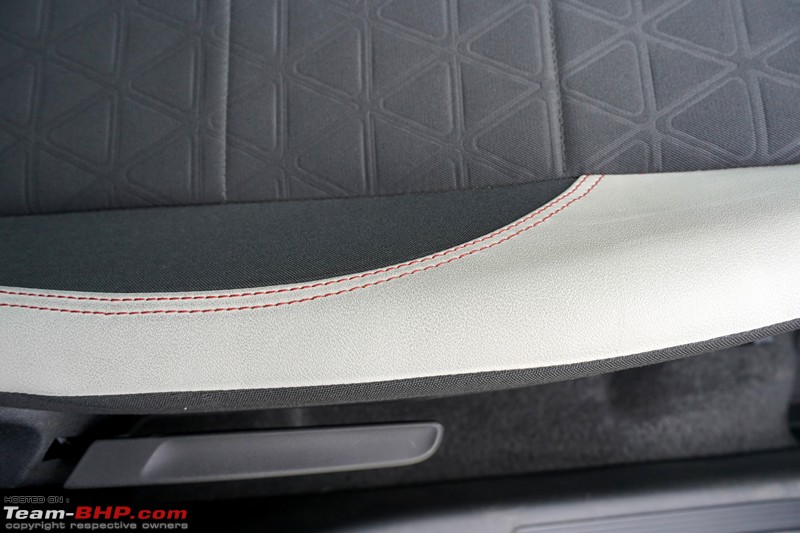 The perforated leather seat upholstery of the top-end 1.0 variants. Perforated material is mandatory for the seat's cooling function. The quality of materials used is good:  Lower variants of the 1.0 TSi get different fabric covers:  Even the top variant does not get electric seat adjustment. Lumbar adjust is not provided, but back support is fine. The seat offers a healthy adjustment range (fore & aft and height) and even a 6-footer will be comfortable:  The center armrest has a soft leather cladding with white stitching (strange misfit, as the seats get contrast red stitching!!!). It is adjustable and placed at a comfortable height:  Seatbelts aren't adjustable for height. Still, the position is neutral and no one will have an issue:  In the manual transmission variants, the ABC pedals are well spaced out, as in the Kushaq. The top-spec GT DSG trim gets these sporty aluminium pedals. A very useable dead pedal has also been provided:  Bundled 3D mats have a raised lip on the sides, offer a snug fit and are easy to clean. They look premium:  Music is played through 6 speakers, including one mid-bass unit on each door and tweeters on the A-Pillars. No fancy branding for the audio here. Big miss as compared to the Kushaq is a subwoofer: 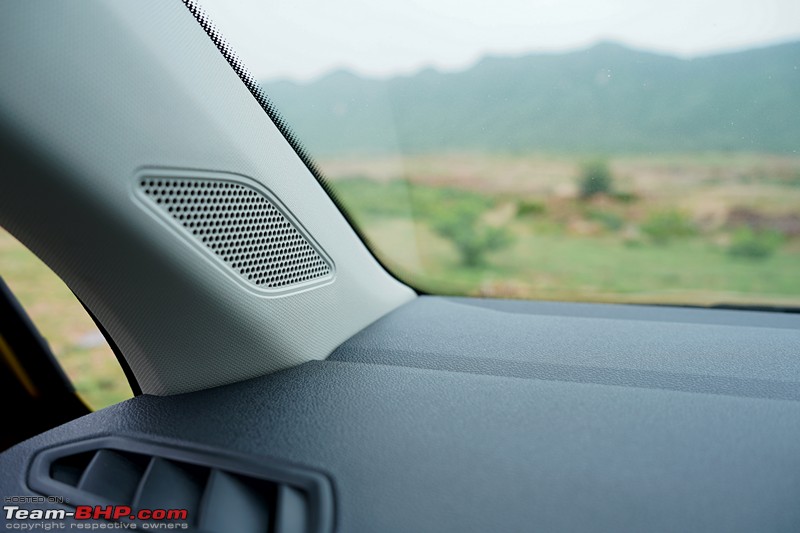 We feel that VW has gone for form over function with the ORVMs. We would have liked them to be a size bigger in terms of width. They should have extended out more and you will find yourself craning your neck when joining the main road, or when taking a U-turn. Notice how the driver can see the blinker from the inside (like in many other VAG cars):  IRVM gets a slim frame and an auto-dimming function. It is wide enough to cover the rear windshield. Headrests (including one for the 5th occupant) do restrict visibility to some extent: 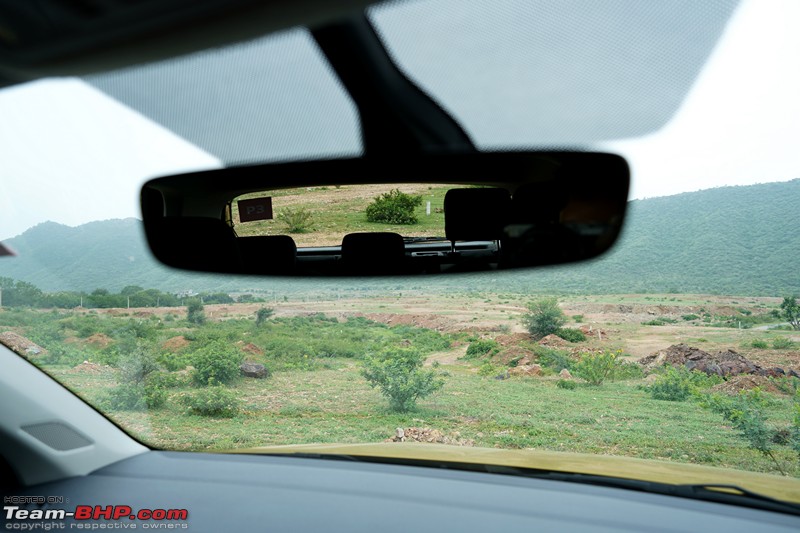 Like most crossovers, the rearward view is average at best. Because of the thick C-pillars and protruding headrests, it’s better to rely on the reversing camera and parking sensors: 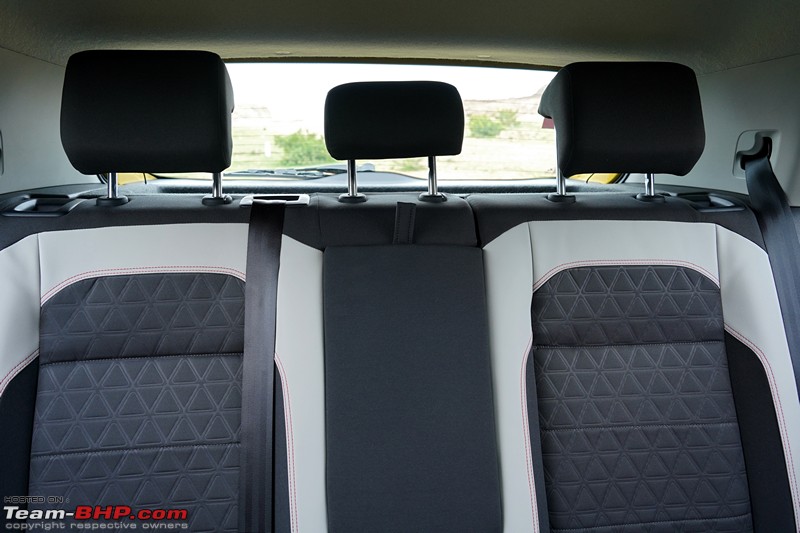 The center fascia hosts a 10” touchscreen at the top, which provides almost identical functions as in the Kushaq. There is liberal use of painted grey inserts around the center console: 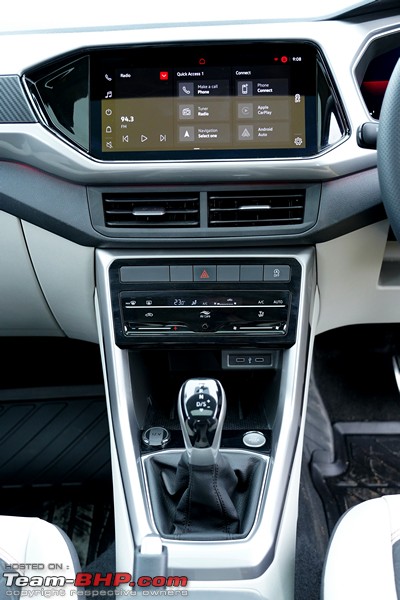 On red cars, the cherry red theme is carried over to the center console as well. 6-speed gear-shifter in the 1.5L GT is absolutely superb with smooth, short throws and well-defined gates: 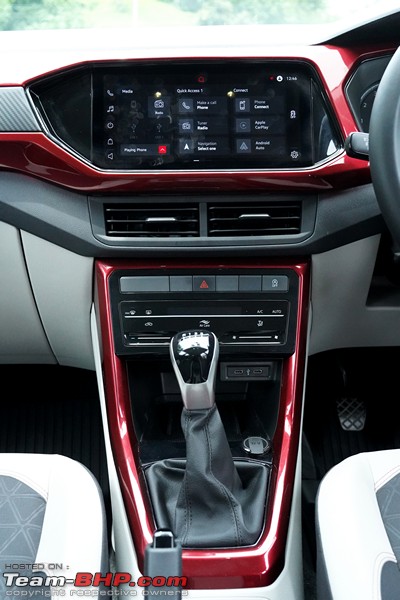 Mid and top-spec variants get a Climatronic climate control system with an "Air Care" air purifier and a touch-and-slide function for adjusting the temperature and blower speed. Even on the move, the sliders are easy to operate without taking your eyes off the road as they are placed in a perfectly recessed area. Buttons for the idling start/stop system, hazard lamps and ventilated seats are located above. Ventilated seats sure are a boon in our hot climatic conditions, but VW has inexplicably limited the feature only to the top-spec 1.0 TSI trim: 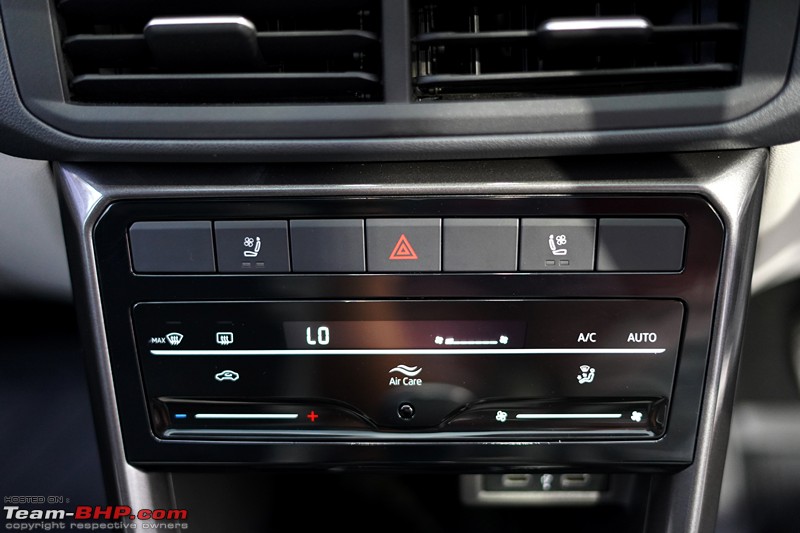 GT MT and lower-spec versions miss out on keyless start-stop. Instead, a 12V socket is provided ahead of the gear lever on the RHS. The Taigun is equipped with a wireless charging pad along with two Type-C USB ports as well. Gloss black plastic trim is prone to scratches: 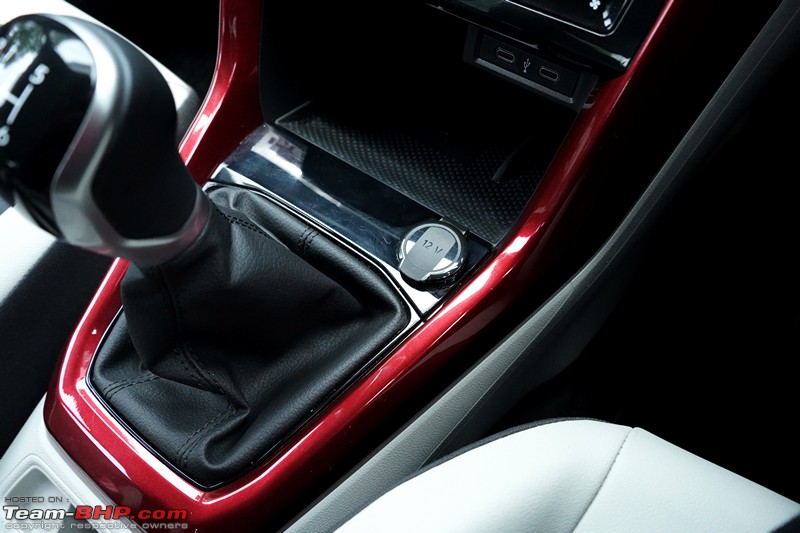 The passenger's side of the dashboard gets a shiny painted panel with contrast finishing in the center. While the GT variants get a pseudo carbon-fibre finish (no texture here)... 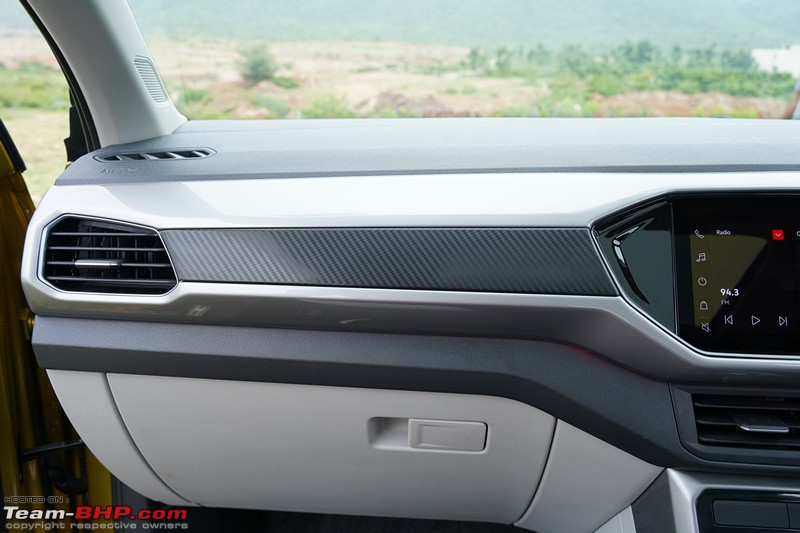 ...the 1.0 gets a glossy texture with a different pattern (personally, I think this looks much better than the pseudo carbon-fibre finish): 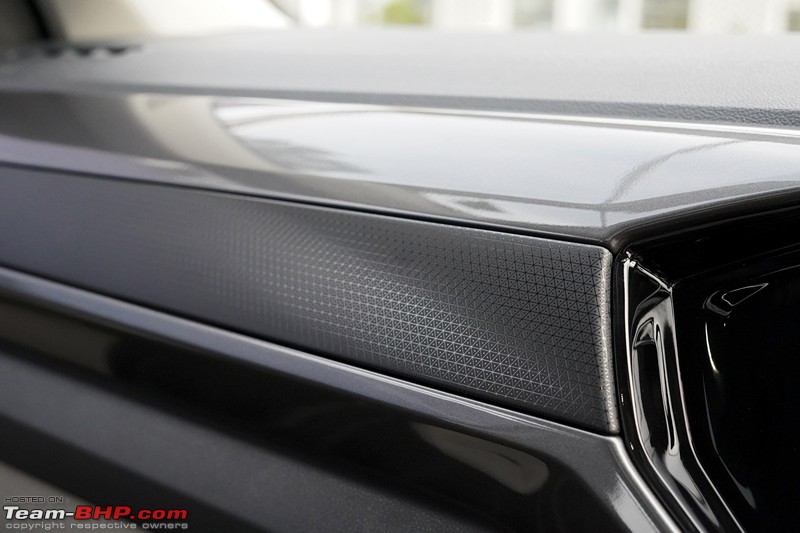 ] ]Bird's eye view of the center console. Cupholders get a rubber base with grips to hold the bottle in place so that the driver can open it with a single hand: 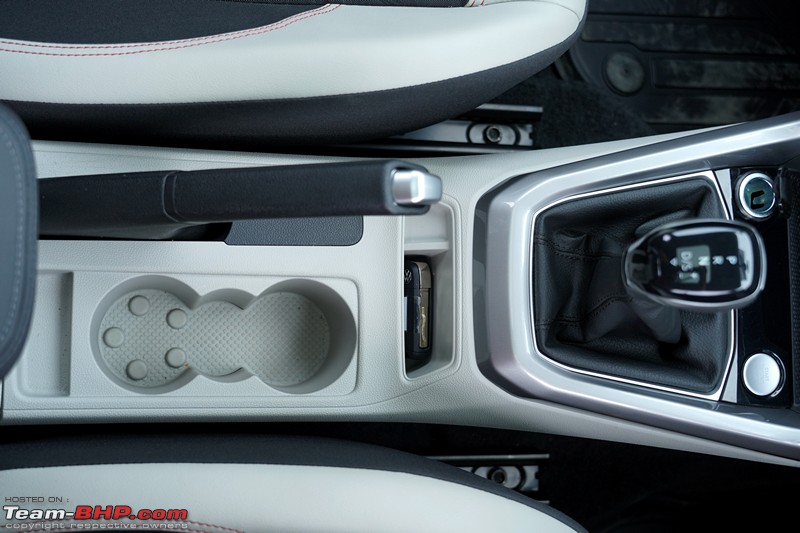 Ahead of the cupholders is a deep slot to place a smartphone:  Beneath the center armrest is a deep, but narrow storage compartment: 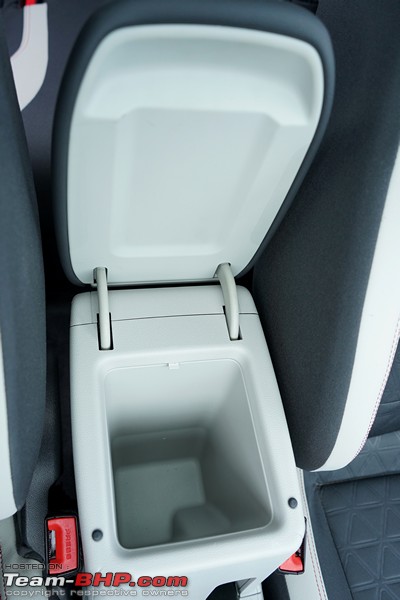 The glovebox is large, cooled and accommodating, but it lacks a light. While the glovebox's opening & closing actions feel very solid & satisfying, a softer damping action for the lid would have lent it a premium feel: 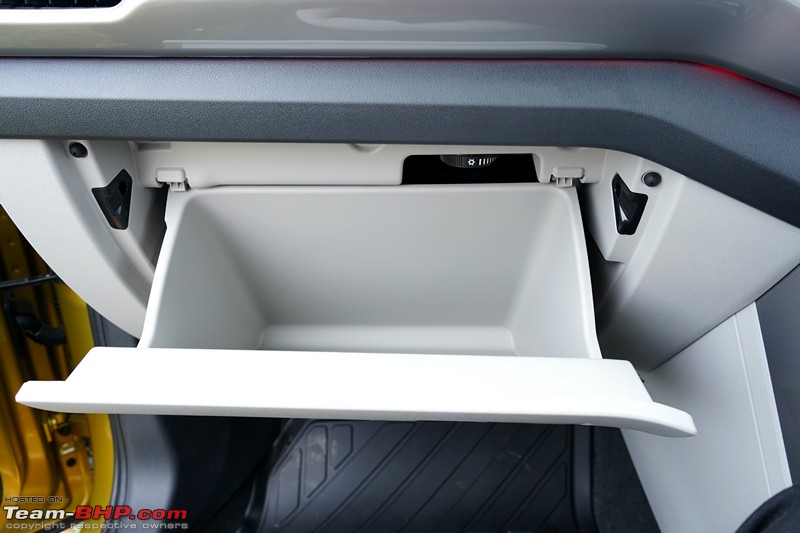 The roof bezel holds two individual lights, sunroof controls and the Bluetooth mic:  Sunvisors have a basic design, yet they don’t feel flimsy. The driver-side unit merely gets a flap to hold slips (no mirror or illumination), while the passenger-side piece gets a vanity mirror, but there's no cover or light provided. We found the roof liner quality to be budget-grade and more suitable to a B-segment hatchback, not a crossover that's going to cost much higher: 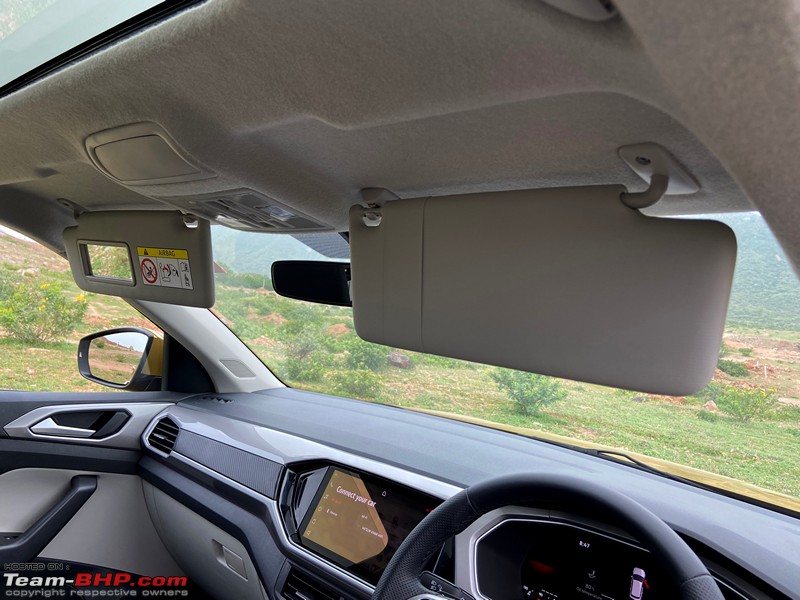 The Taigun gets an option of up to 6 airbags in total, including dual front airbags, side airbags (no seat covers please) and curtain airbags. We have mentioned it earlier and feel it needs to be mentioned again - Volkswagen should consider giving a top-end 6 airbag version on both the MT and AT variants of the Taigun:  While some of the competition offers a panoramic sunroof, the Taigun makes do with a regular unit, which is fairly sized for the cabin: 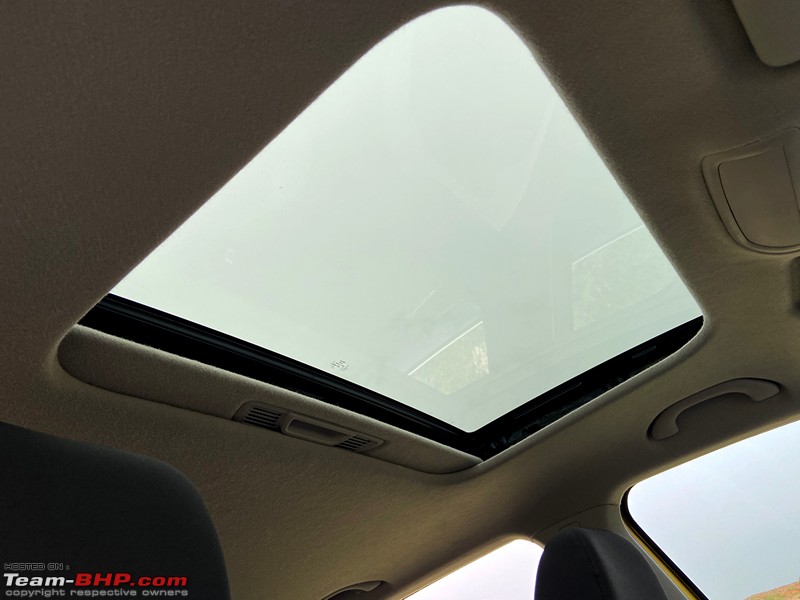 Simple flippy key feels good to hold. On the flip side (pun intended), it is from the last generation VW cars (the newer ones get the gloss black keyfobs like the one bundled in the new Octavia), looks basic and misses out on features such as remote engine start which some of the competition offers:  Two visible fit and finish issues were noticed in an otherwise well-finished cabin. Call it nitpicking, but since the launch is still a few weeks away, I hope Volkswagen takes note of these problems and fixes them: 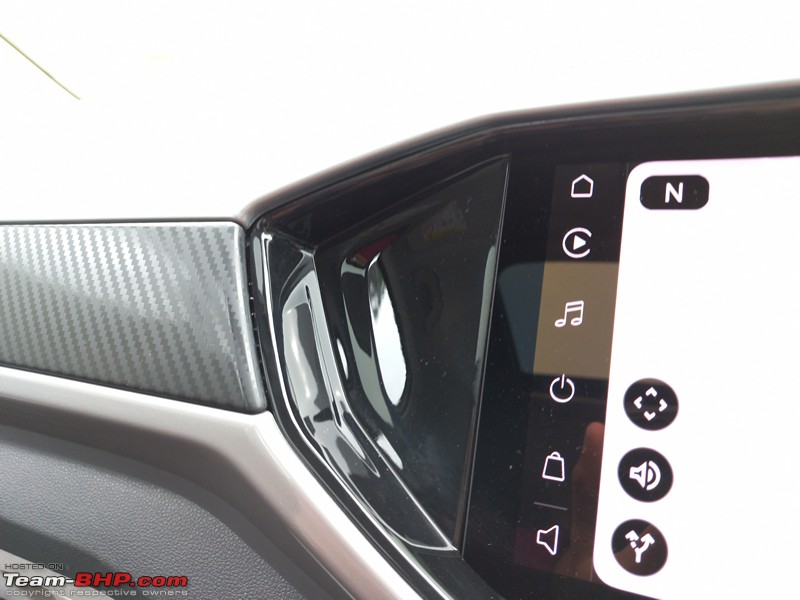 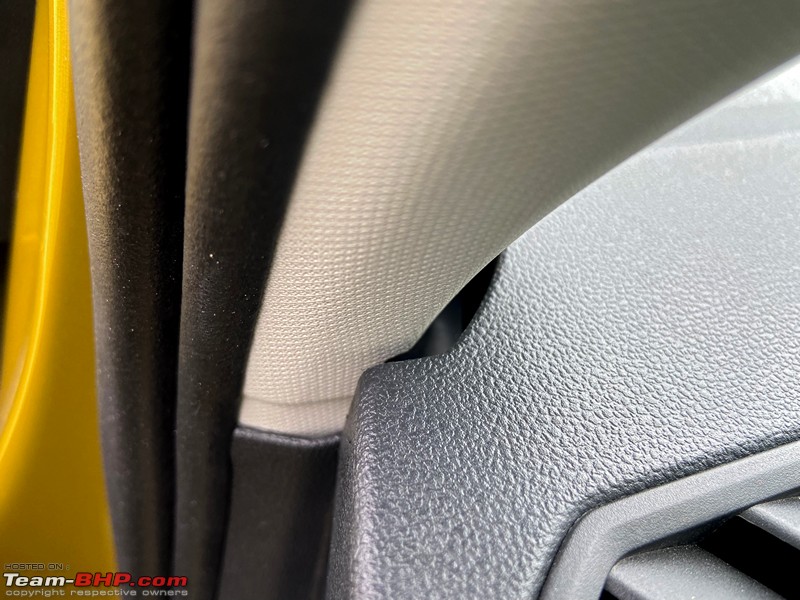 Last edited by Aditya : 12th August 2021 at 16:07. |
| |  (59)
Thanks (59)
Thanks
 |
| The following 59 BHPians Thank CrAzY dRiVeR for this useful post: | Abhinav_2502, Aditya, ashis89, ashking101, AtheK, Autocaptive, Avikbrio, a_chelat, CARDEEP, CEF_Beasts, chinmaypillay, Crazy_cars_guy, deepfreak15, Dr.AD, fluidicjoy, Gannu_1, GaryTSI, Geta, GTO, hdman, hemanth.anand, hillsnrains, InControl, Jaggu, jazzrockz, JoshMachine, Karthik R, klgiridhar, kutts, lemedico, Livnletcarsliv, Meph1st0, museycal, Mustang Sammy, na_agrawal, Nrulz, Osteon206, PGNarain, RaghuVis, RavenAvi, regenitin, Rehaan, Reinhard, Researcher, saikarthik, sam2007$, Samba, sangam_mm93, searacer932, shipnil, The_Outsider!, TorqueIndia, Varun_HexaGuy, vb-saan, vbd316, Venkatesh, VivekCherian, vvrchandra, Xaos636 |
| | #5 |
| Team-BHP Support  | Rear doorpads have an identical theme to the front ones. Only mid-bass speakers are housed in them, no tweeters. The front and rear doors, both, open in a triple-stage action. Wide door pockets can hold a water bottle and other knick-knacks with ease:  Legroom is surprisingly healthy and even two 6-footers can sit one behind the other:  A glance at the minimum / maximum legroom available:  I'm 5'11", with a good build and had knee space to spare when I sat behind my own driving position. The backrest is set at a comfortable angle and the bench is supportive. Under-thigh support is satisfactory, as evident in this picture. I had ~3 inches of headroom to spare:  The center armrest is positioned at a comfortable height. It is wide & soft, and comes with two cupholders. The way the fabric is wrapped on it though leaves a lot to be desired. Look closely and you'll see lots of rough edges...as if it was done at a local aftermarket shop:  Rear seat has nice contours for support. While three 3-point seatbelts and three adjustable headrests have been provided, the rear seat is better suited for 2 adults and a kid (rather than 3 healthy adults). If it is two overweight adults, even a kid cannot be accommodated. Also, the middle area of the backrest protrudes (due to the armrest) and the seat base is elevated in the center. The headrests have a firm compound:  Rear bench gets ISOFIX child seat anchors on both sides:  Window line rises toward the rear. Shorter occupants will find this restricting their view outside. The rear glass rolls down all the way. While the bottom half is dark-coloured, a lighter top ensures one doesn't feel stuffy inside:  The top-end variants get tinted windows, though they are barely noticeable. Darker tints, as seen in the Polo 1.0 TSI, sure would have been welcome in these sunfilm-less times!  Both front seats have deep seatback pockets, but miss out on the very handy smartphone pockets provided in the Kushaq:  Two Type-C USB charging ports are provided below the simple rear vents. Wish VW had provided at least one Type-A port which is more widely used today:  Spring-loaded grab handles get coat hooks. They are nicely recessed inside the roof moulding, but have almost no damping in the return action which robs them of a premium feel. Not the VW we know:  Floor hump is medium-sized, but still, this isn't a car in which a 5th adult will be welcomed:  Rear light console is sharp looking! It consists of two individual LED lights:  Whitish roof liner is scooped out where headroom is required:  Although the specs have not been disclosed, boot space should be similar to the Kushaq's 385 liters. On paper, this is more comparable to sub-4 meter crossovers like the Sonet (392L) & WR-V (363L) rather than the Seltos (433) or Duster (475L). That said, useable space seems to be on par (or better than) its direct competitors. A wide tray with a prominent border has been provided:  The boot is well-shaped and weekend holiday luggage for your family should easily fit in:  Practical bag hooks on both sides of the boot: 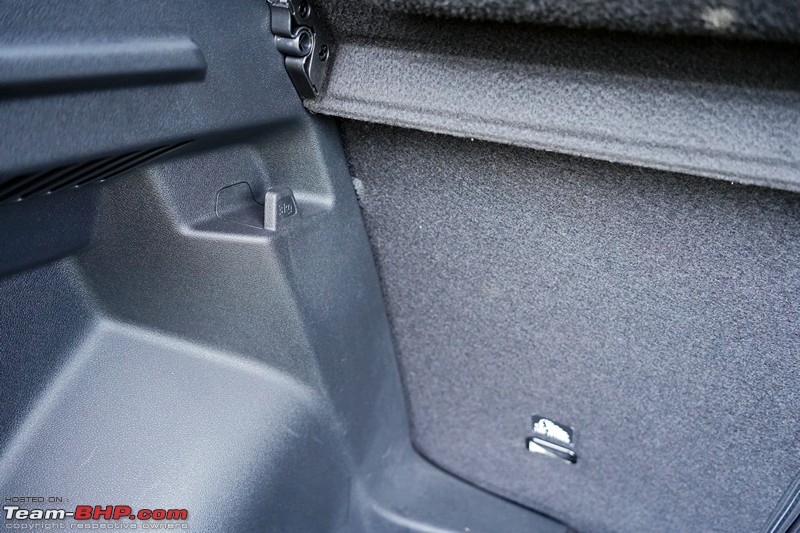 The boot light and first-aid kit are on the right:  Tools are stored neatly in the spare wheel well. No spare wheel-mounted subwoofer here, as in the Kushaq. No subwoofer is a big, big miss at this price point. Spare is a 16” rim with a 205/55 section tyre:  Rear seats can split in a 60:40 ratio. Folding the seatbacks down should give you around the same cargo capacity as the Kushaq. Floor is far from flat though:  Tailgate gets partial cladding on the inside:  A plastic piece has been provided to pull the tailgate down. Different from the kind of handles we usually see:  Disclaimer: VW invited Team-BHP for the Taigun test-drive. They covered all the travel expenses for this driving event. Last edited by GTO : 16th August 2021 at 10:19. |
| |  (84)
Thanks (84)
Thanks
 |
| The following 84 BHPians Thank CrAzY dRiVeR for this useful post: | Abhinav_2502, abhishekd, Aditya, Akshay6988, amit1agrawal, amvj, Anis Ahmed, Arnav Vaghela, AROO7, ashis89, ashivas89, ashking101, AtheK, Autocaptive, autospeaker, Avikbrio, a_chelat, BlackPearl, CARDEEP, catchjyoti, CEF_Beasts, chinmaypillay, Crazy_cars_guy, Deadpool, deepfreak15, Desmosedici, DetonatoR, EmpyreanKnight, FloatingCanvas, Gannu_1, GaryTSI, GST, GTO, Harjot37, hdman, hemanth.anand, InControl, Jaggu, jazzrockz, JoshMachine, kamilharis, Karthik R, Keeleri_Achu, KrisTvpm, Livnletcarsliv, lovetorque, Mohan Mathew A, museycal, na_agrawal, Nrulz, Omkar, OnePM, Osteon206, PGNarain, RaghuVis, Rajeevraj, RavenAvi, regenitin, Rehaan, Researcher, Rigid Rotor, Roy.S, rputr001, saikarthik, sainyamk95, sairamboko, saisree, sam2007$, Samba, sangam_mm93, searacer932, sunikkat, swoosh, The_Outsider!, TorqueIndia, varkey, Varun_HexaGuy, vb-saan, vbd316, Venkatesh, VinNam, VivekCherian, vsrivatsa, vvrchandra |
| | #6 |
| Team-BHP Support  | Re: Volkswagen Taigun Review Thread moved out from the Assembly Line. Thanks for sharing! Last edited by Aditya : 9th August 2021 at 10:05. |
| |  (12)
Thanks (12)
Thanks
 |
| The following 12 BHPians Thank Aditya for this useful post: | ashis89, CrAzY dRiVeR, fluidicjoy, Gannu_1, GTO, JoshMachine, kamilharis, Reinhard, Researcher, rputr001, VinNam, vvrchandra |
| | #7 |
| Team-BHP Support  Join Date: Apr 2013 Location: Madras
Posts: 7,288
Thanked: 20,455 Times
| First off, I must thank GTO for giving me this break and Crazy Driver (Sujai) for tagging along for this drive. Guys, Sujai and I had a proper B-L-A-S-T during this media drive especially with the brutal 1.5 TSI + DSG combo, putting it through its paces on the beautiful 4-laned roadway from Udaipur to Pindwara! The grin on our faces says it all: 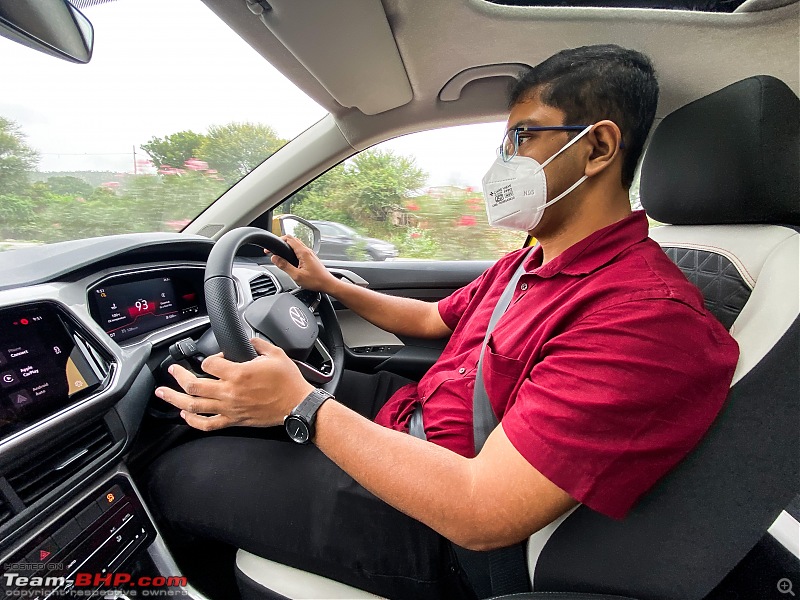  Thanks to the embargo which was in place, I had to control my urge to comment on the previous Taigun thread; I wasn’t quite sure if I would reveal too many details by posting something and cross the line! We were blown away with the 1.5 TSI + DSG GT variant and felt this was a proper upgrade for current owners of the 90-100 hp segment hatchbacks (Polo, Punto and the likes). The car just stuck to the road like a leech and easily took corners at high speeds with minimal body roll while dismissing small potholes and minor road undulations (the test car’s tire pressures were set at 32 psi before we started the drive). While I am warming up to crossovers, I would still prefer a hot hatch with a powerful engine (like this 1.5 TSI) over a crossover any day. And I feel so envious of CD right now because he is planning to switch from his Punto 90 hp and he’s at the crossroads - the Kushaq or the Taigun! And I can already smell what it is going to be! If I were him, I would bet on the top-end Taigun GT variant in the 1.5 TSI DSG guise because it comes with 6 airbags and the DSG, despite having a feeling of traveling in a ticking time-bomb. I would take the maximum warranty that I can right off the delivery (standard 4 years/1,00,000 km that comes with the car + extended 2 years/50,000 km) and swap the stock 17” gloss black alloys with these: 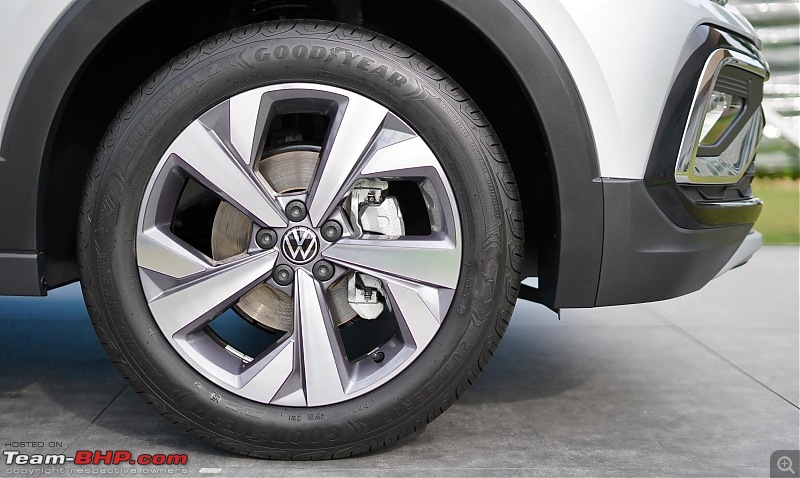 That way, at least I am set for 6 years! I would also get the excessive chrome bits on the front and rear bumpers blackened. Gosh, this was an eye sore! Clearly VW has gone with the market sentiment - chrome, chrome and more chrome. If customers throng accessory shops to add more bling to their rides, might as well give them from the factory? Oh well! On the front and rear bumpers, on the door handles, on the front grill, on the headlamps, on the tail lights, on the GT badging on the fenders! There’s enough contrast on the front and rear bumpers with the fake diffusers finished in grey. Here’s what I mean: 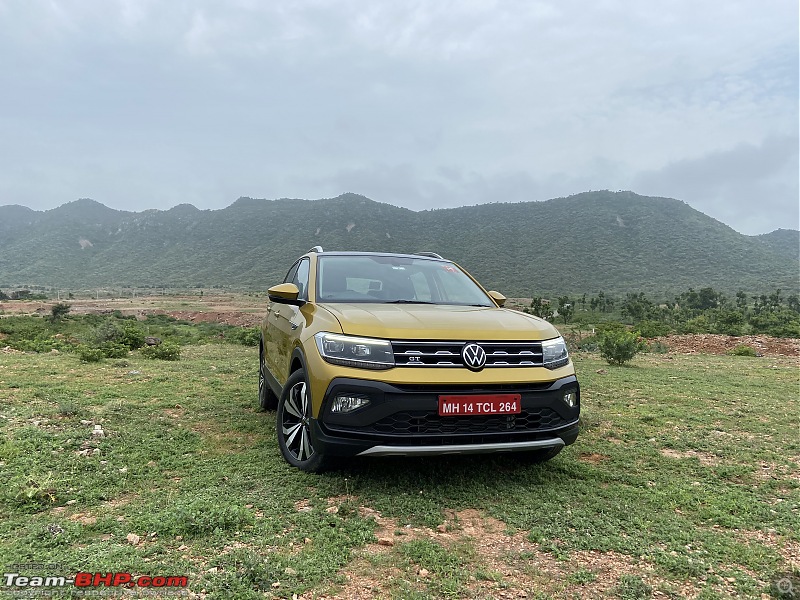  I know a few more who are planning to jump the gun from an aging Polo and have recommended the Taigun to them. I greatly value engine dynamics, road manners and high-speed stability over creature features and therefore, the Germans easily tip the scale over the Koreans. Pricing will definitely be the key here and I expect a small markup for the Taigun over the Kushaq. Make no mistake - the Taigun is to Kushaq just like the Vento is to the Rapid. They are exactly siblings with minor changes to the exteriors and interiors. Skoda somehow messed up the kitting of the Kushaq’s variants by skimping on the airbags on the top-end Kushaq 1.5 TSI DSG Style variant. All said and done, the Taigun does have some minor flaws and some niceties missing. As an existing Polo owner, I was surprised to find some of the existing features from the Polo/Vento missing such as the auto up-down windows for all the doors (in the Taigun, only the driver side door had it), anti-pinch feature for all the windows (we tested and found that the Taigun lacked this; prospective owners with kids, please be careful about this!), the gap between the A-pillar trim and the dashboard which caught my eye, the trim on the co-driver side dashboard which had a noticeable gap between the dash (not usually seen on VWs), dampers on the interior grab handles (come on VW, this damper barely costs anything; even the Dzire taxi had it!), the missing underbody protection for the powertrain (hopefully, this is sold as an accessory; we need this for Indian roads!), physical knobs for the climatronic unit (I would prefer knobs for the temperature and blower speed adjustment so I don’t have to take my eyes off the road to adjust them), missing height-adjustable seat belts, empty plastic trim on the roof liner next to the cabin light (could have omitted the trim altogether than give that part!) etc. Not deal breakers but an omission nonetheless. Then, there are some of them who are also likely to skip the Taigun top-end variant for its bigger brother built and shipped from the Europe - the T-Roc, for a slightly higher price tag. For approx. INR 4 lakhs more than the Taigun or the Kushaq, here’s what you’ll get on the T-Roc:
What will you miss out on the T-Roc compared to the top-end Taigun 1.5 TSI DSG?
If I had the budget for the Taigun 1.5 TSI DSG, I would really put the T-Roc in contention! Good time for the DIYers and modifiers too - I can already see the potential DIY/retrofit options lined up for the Taigun - front parking sensors with the 8K optical parking system, changing the instrument cluster from the analog units on the lower variants to the digital unit and even the existing digital clusters to the virtual cockpit display from the T-Roc, installing the KESSY - keyless entry and drive system, gas struts to lift the bonnet (plenty of space on the sides where the bonnet rests), adding a windshield washer fluid level warning light (assuming the stock cluster has the provision for the warning light and an SMD LED soldered to the board), adding a damper and light to the glovebox lid (come on, even the humble Tiago gets a damped glovebox lid; gives it a premium feel!) the different VCDS/OBD11 mods that can be done (including disabling the 80/120 kmph speed alerts  ) and so forth! ) and so forth!Those would be my thoughts. Thanks for reading guys! Trust you liked our review. Until next time… Last edited by Gannu_1 : 11th August 2021 at 08:35. Reason: Added 1.5 TSI DSG to the Taigun in the comparison with T-Roc. |
| |  (137)
Thanks (137)
Thanks
 |
| The following 137 BHPians Thank Gannu_1 for this useful post: | 400notout, abhi9044, Abhinav_2502, achyutaghosh, Aditya, akash_v12, Akmal, Akshay6988, amarendernag, amit1agrawal, amvj, apoorvdurga, aravind.anand, AROO7, ashis89, ashking101, AtheK, ATRONIX, Autocaptive, Avikbrio, AYP, a_chelat, batladanny, BlackPearl, BMvW.Rajat, CARDEEP, Carz77, catchjyoti, CEF_Beasts, chinmaypillay, Cooltronics, CrAzY dRiVeR, Crazy_cars_guy, Deadpool, deepakhon, deepfreak15, delta5, DetonatoR, Doonite, Dr.AD, Dr.Naren, DrANTO, drivingmelody, EmpyreanKnight, Fateh Salim, FloatingCanvas, fluidicjoy, GaryTSI, GeeTee TSI, Geta, gigatech2006, gopi_rm, GTO, Harjot37, Hayek, hdman, hemanth.anand, HMV, iamswift, ike, InControl, Jacob1000, Jaggu, jazzrockz, jithin23, JoshMachine, kamilharis, Karthik R, Keeleri_Achu, Keynote, KINI, klgiridhar, KrisTvpm, lamborghini, LaRoca, Latheesh, Livnletcarsliv, lovetorque, McLaren_P1, Mohan Mathew A, Mu009, museycal, na_agrawal, nitinkbhaskar, NitSat, Nrulz, Omkar, OnePM, Osteon206, PrasunBannerjee, Punatic, QuentinTino, RaceHorse, RaghuVis, rahil_29, rAijin_, Rajeevraj, RavenAvi, regenitin, Rehaan, Reinhard, Researcher, rkv_2401, rputr001, saikarthik, saikishor, sainyamk95, saisree, sam2007$, Samba, sangam_mm93, Sayan, searacer932, Senna_sempre, shancz, shipnil, Shome, sknair, stringbh, supertinu, sups, TDCi4Life, The_Outsider!, Timothy, TorqueIndia, TurboGuy, VaibhaoT, vb-saan, vbd316, veedub, VinNam, vinya_jag, vishy76, VivekCherian, vivekn83, vvrchandra, YashD |
| | #8 |
| Team-BHP Support  | Re: Volkswagen Taigun Review Thank you guys for a deadly, detailed review! The best there is, as always  . . Just wanted to add that we are 90% sure of VW not offering a 1.5 TSI MT in the top variant, but it is one that can be corrected by the time of launch. So let's not discuss it too much until the launch day. This could be confirmed that day (and would be a grave error), or VW could simply correct its folly as the company has ample time to. If you ask me, there is no reason for them to not offer the 1.5 TSI MT top variant. It is the AT top variant that causes 'sticker shock', not the 1-lakh cheaper MT. We hope VW does eventually please MT fans on launch day. |
| |  (40)
Thanks (40)
Thanks
 |
| The following 40 BHPians Thank GTO for this useful post: | 400notout, Akshay6988, anshuman1117, ashis89, AtheK, CEF_Beasts, CrAzY dRiVeR, Crazy_cars_guy, Dr.AD, FloatingCanvas, Gannu_1, GaryTSI, hdman, JoshMachine, klgiridhar, museycal, Nitish B Shetty, Nrulz, Old_Salt, Osteon206, PearlJam, PetrolHead2272, PrasunBannerjee, QuentinTino, Rajeevraj, RavenAvi, Rehaan, Reinhard, Researcher, rputr001, Samba, Sen, TDCi4Life, The Rationalist, TorqueIndia, vb-saan, VinNam, VivekCherian, viXit, vvrchandra |
| | #9 |
| BHPian Join Date: Sep 2020 Location: Pune
Posts: 97
Thanked: 862 Times
| Re: Volkswagen Taigun Review Great review with lots of details guys! Kudos. And nice comparo with the T-Roc in the end too. As with Kushaq, the usual riders will apply with Taigun too when it will come for consumers to decide with their purses. Taigun will win hearts of few and will make less sense to many vis-a-vis the Creta and Seltos duo. I still don't get the feature distribution decisions in Kushaq and Taigun from SVWIPL. It's as if they decided - 'Alright, we have 2 legs, let's shoot ourselves in one before we start the race!' |
| |  (7)
Thanks (7)
Thanks
 |
| The following 7 BHPians Thank museycal for this useful post: | contact.nitin7, devilwearsprada, Harjot37, InControl, LaRoca, naadopaasaka, Shreyas |
| | #10 |
| BHPian Join Date: Apr 2019 Location: Bangalore
Posts: 535
Thanked: 3,836 Times
| Re: Volkswagen Taigun Review One of the most detailed reviews with loads of clear pictures and as museycal mentioned, it was good to have the Kushaq reference. Taigun looks elegant, carries that European design from VAG, but also a lot of chrome! The proportions are brilliant, from some angles it reminds me of Audi Q3+Polo combo (not saying it's influenced, but I get reminded of this). The front has that butch that is needed for a SUV, but the rear is more modern and I feel the lights are generally well designed by VW, but this doesn't give that feel (subjective). The interior looks clean and futuristic, I liked the ambient lighting effect with the cluster and infotainment a lot. The infotainment looks too glossy, wonder if they have anti-glare glass/layer on it. The MID digital cluster looks well designed, but I feel the resolution is on slightly lower side for the graphics that is hosts. Brilliant packaging to get more space and few quirks implemented to perfection like the first aid kit strapped on the rear wheel arches is a space saver (but accessing from inside in the event of crash and passengers getting pinned down is tricky. A lot of cost cutting has been done like the insulation, underbody area and also one mold tailgate cover. Few points what I didn't like much, 1. The front grille with those elements are copied & rotated 180 degrees from Renault Duster I guess. 2. Wat the hell is that keyfob? doesn't look like VW's at all. Last edited by saikarthik : 9th August 2021 at 10:59. |
| |  (2)
Thanks (2)
Thanks
 |
| The following 2 BHPians Thank saikarthik for this useful post: | FloatingCanvas, InControl |
| | #11 |
| BHPian Join Date: Jul 2020 Location: Kottayam,DXB
Posts: 631
Thanked: 2,918 Times
| Re: Volkswagen Taigun Review Thanks to Crazydriver and Gannu_1 for such a detailed review. Between TAIGUN & KUSHAQ, the former looks instantly attractive for me, also TAIGUN got a good presence from the front than KUSHAQ. Had a grudge against VW group for lugging polo family for those 12 years without generation update even after the global unveil of the new generation, now I'm fine with their offering which is going to serve all those POLO & PUNTO customers who are not yet upgraded. I'm seeing these compact SUVs CRETA, SELTOS, DUSTER, KICKS, KUSHAQ & TAIGUN as sub 15lakh cars. It would have been nice and affordable if VW provide AT option right from 1.0L base variants. Meanwhile media drive had only 1.5 variants? Good luck VW hoping for atleast 4-6K pm volume addition with the new product. Last edited by TorqueIndia : 9th August 2021 at 10:41. |
| |  (2)
Thanks (2)
Thanks
 |
| The following 2 BHPians Thank TorqueIndia for this useful post: | InControl, Osteon206 |
| |
| | #12 |
| Senior - BHPian Join Date: Oct 2010 Location: Bangalore
Posts: 1,813
Thanked: 5,871 Times
| Re: Volkswagen Taigun Review The GT Spec loses out quite a number of features, compared to the GT+ Spec & even the Kushaq 1.5TSI Manual. I have a feeling, that the Taigun 1.5 GT may undercut the Kushaq 1.5 manual by a substantial margin! |
| |  (1)
Thanks (1)
Thanks
 |
| The following BHPian Thanks abhishek46 for this useful post: | InControl |
| | #13 |
| BHPian | Re: Volkswagen Taigun Review Great review! The lack of all 4 discs, hood cladding, and engine protection at this price point(I'm guessing it will be priced closer to the Kushaq) is quite a miss IMO. Should definitely have had both. Last edited by ashishk29 : 9th August 2021 at 11:22. |
| |  (2)
Thanks (2)
Thanks
 |
| The following 2 BHPians Thank ashishk29 for this useful post: | devilwearsprada, sainyamk95 |
| | #14 |
| BHPian Join Date: Oct 2013 Location: KA21
Posts: 532
Thanked: 2,008 Times
| Re: Volkswagen Taigun Review As always one of the best reviews Sujai and Ganesh! It is an interesting proposition from VW to miss out on creature comforts in 1.5 MT GT trims, having said that I think VW tried to fill the gap which Kushaq had left void. As GTO said it is too early to comment on this but for potential buyers who are at crossroads between Kushaq vs Taigun, decision-making will be straightforward. If you want fully loaded automatic go for Taigun, if MT then Kushaq. Ultimately it is a win-win for the VW group. For people who have already booked Kushaq 1.5MT and are taking delivery this month, their booking should remain unchanged. Last edited by DragonHawk : 9th August 2021 at 11:19. |
| |  ()
Thanks ()
Thanks
 |
| | #15 |
| BHPian Join Date: Oct 2019 Location: Bangalore
Posts: 242
Thanked: 485 Times
| Re: Volkswagen Taigun Review Only yesterday I was telling someone that VW Skoda will do Magnite/Kiger with features. So, you can either have cooled and powered seats or digital cockpit with 6 airbags on top model. |
| |  ()
Thanks ()
Thanks
 |
 |





